 |
Travels in India and Pakistan part 2 - Rajasthan and Punjab: Jodhpur, Osiyan, Jaisalmer, Bikaner, Chandigarh, Amrisar, Waga border Jan - Feb 2009 |
Our route from Mumbai through Gujerat, Rajasthan and Punjab to Islamabad in Pakistan. To return to part 1, Mumbai and Gujerat, please click here. (the link to part 3, Pakistan, is at the bottom of this page.) |
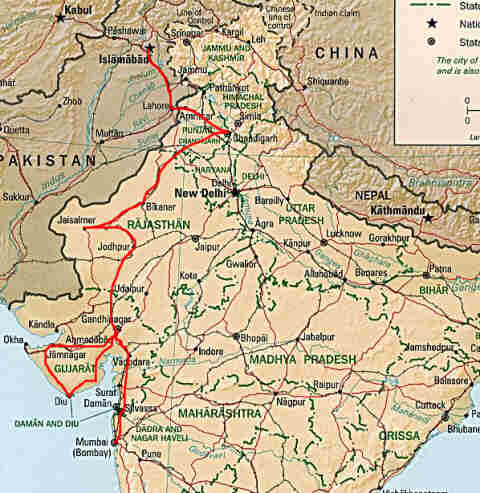 |
Rajasthan - Jodhpur |
Fri 23rd Jan. The train was about two hours late, arriving in Jodhpur about 8:30, but the man from the hotel we had phoned and pre-booked was there to meet us and put us in an auto-rickshaw to 'Singhvi's Haveli', a lovely guesthouse in a 500-year old house in the heart of the old city, with red sandstone walls, hidden staircases and rooms decorated with wonderfully carved wooden doors and window-frames and murals painted on all the walls - at least there are in our room which is the Maharani suite with two bow windows with views of the fort. A haveli is a residence of a chief minister or general, the tier below royalty, and Singhvi's was gifted to the present owners' ancestor by the maharajah of the time. The durbar room where the minister held court is still decorated in the style of the period and has a big ceremonial swing in the middle of the room - if Sheila was missing I knew she'd gone for her daily ritual swing on it! (Below) one of the windows in the Maharani suite in Singhvi's Haveli |
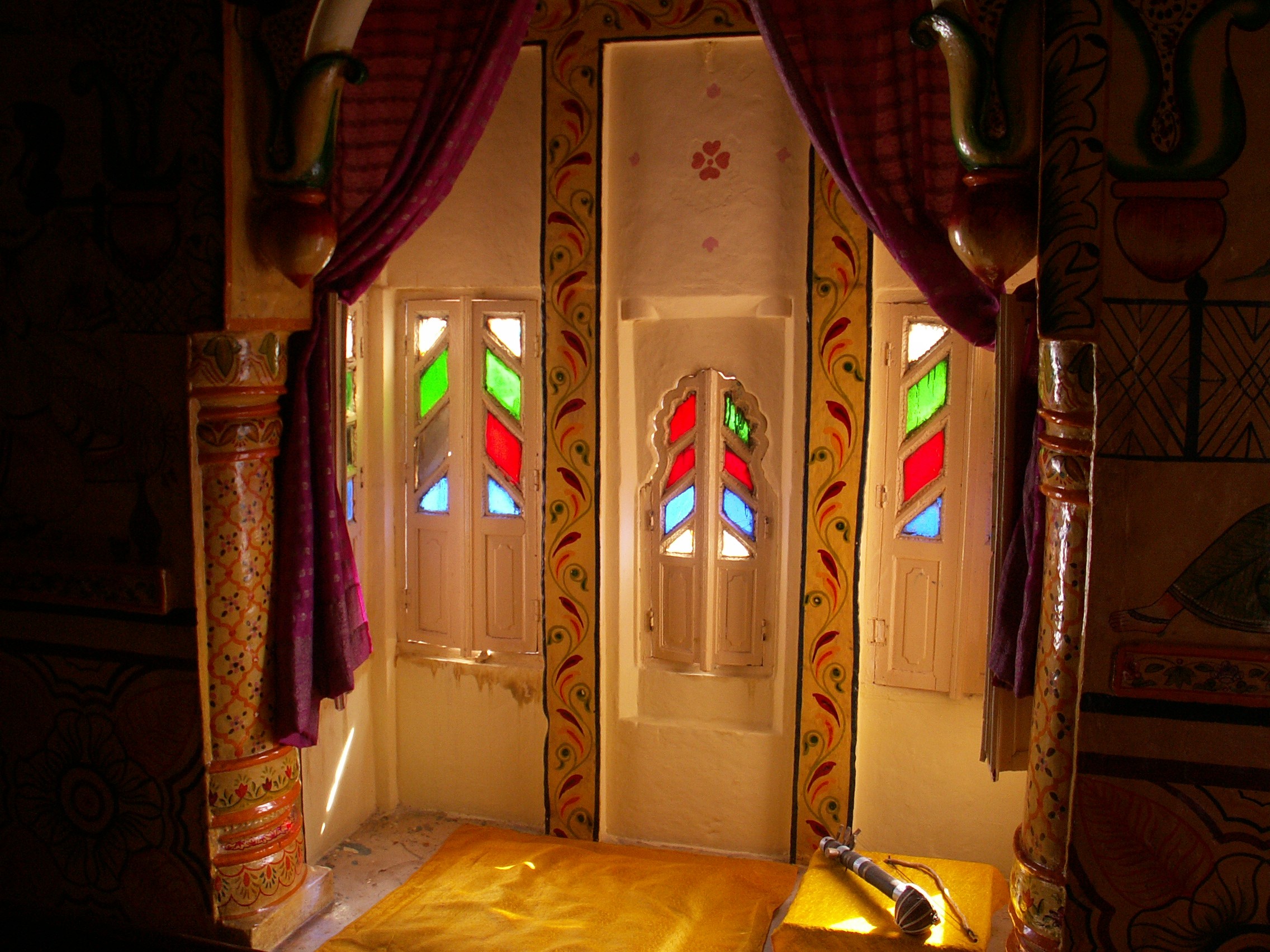 |
We had breakfast at Singhvi's then walked down the narrow, bustling road to try to find the market. We missed the turning and found ourselves outside the city walls in the new town, so we got an auto-rickshaw to the Tourist Reception Centre, a very helpful place where they gave us a good map and we booked a tour to some sights outside town for the day after tomorrow. Another auto-rickshaw took us to the junction of Nai Sarak Street, where we walked up the street back into the old city, with Sheila shopping as we went. We had lunch at the City Palace hotel and carried on up the road to the clock tower, which is in the heart of Sardar Market. |
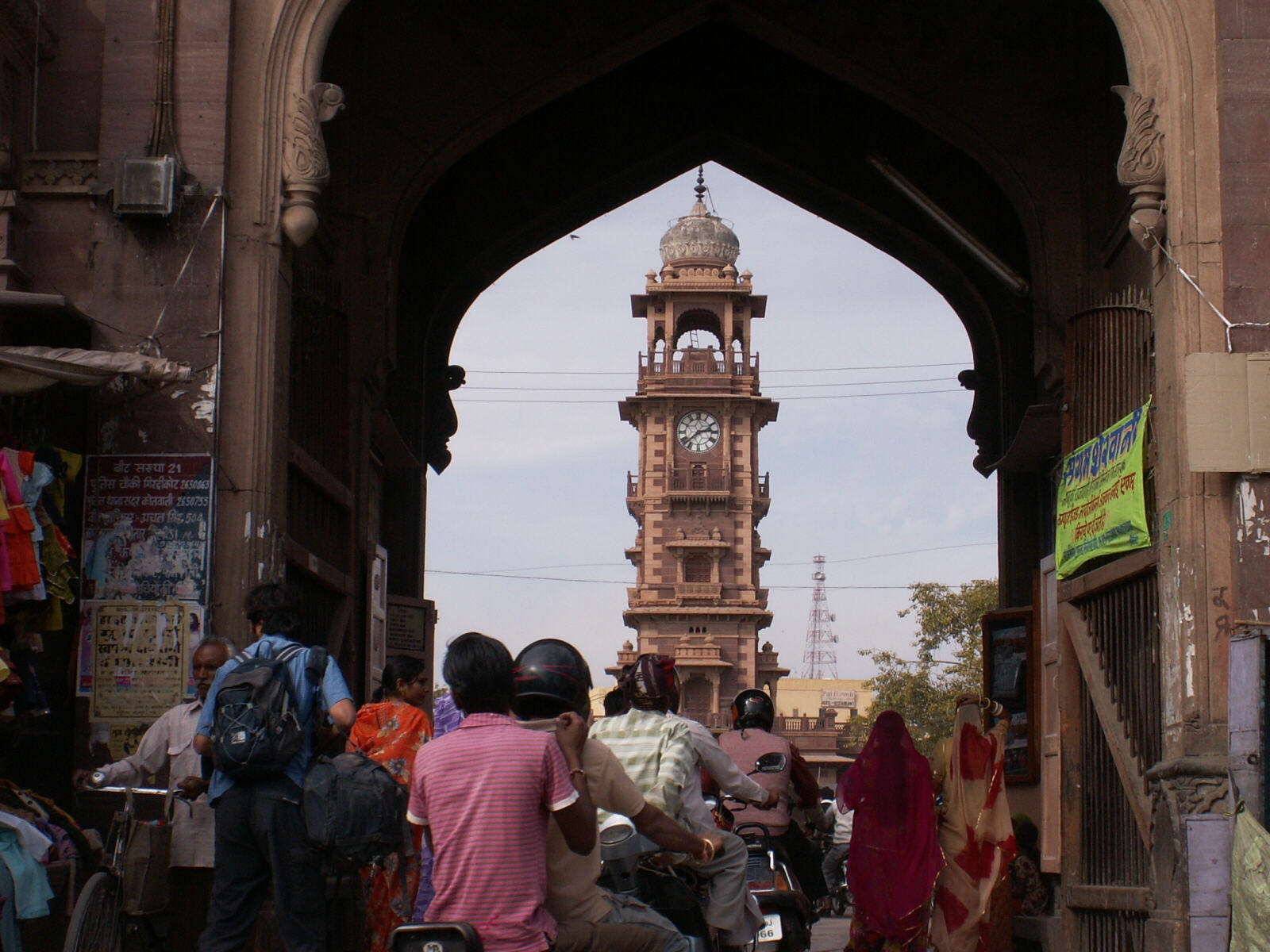 |
Sardar market is a fascinating, seething mass of stalls and barrows selling everything from fruit and veg to bangles and CDs. We watched the colourful lady shoppers, some laden with gold jewellery and bangles including elaborate nose ornaments that looped round their ears. |
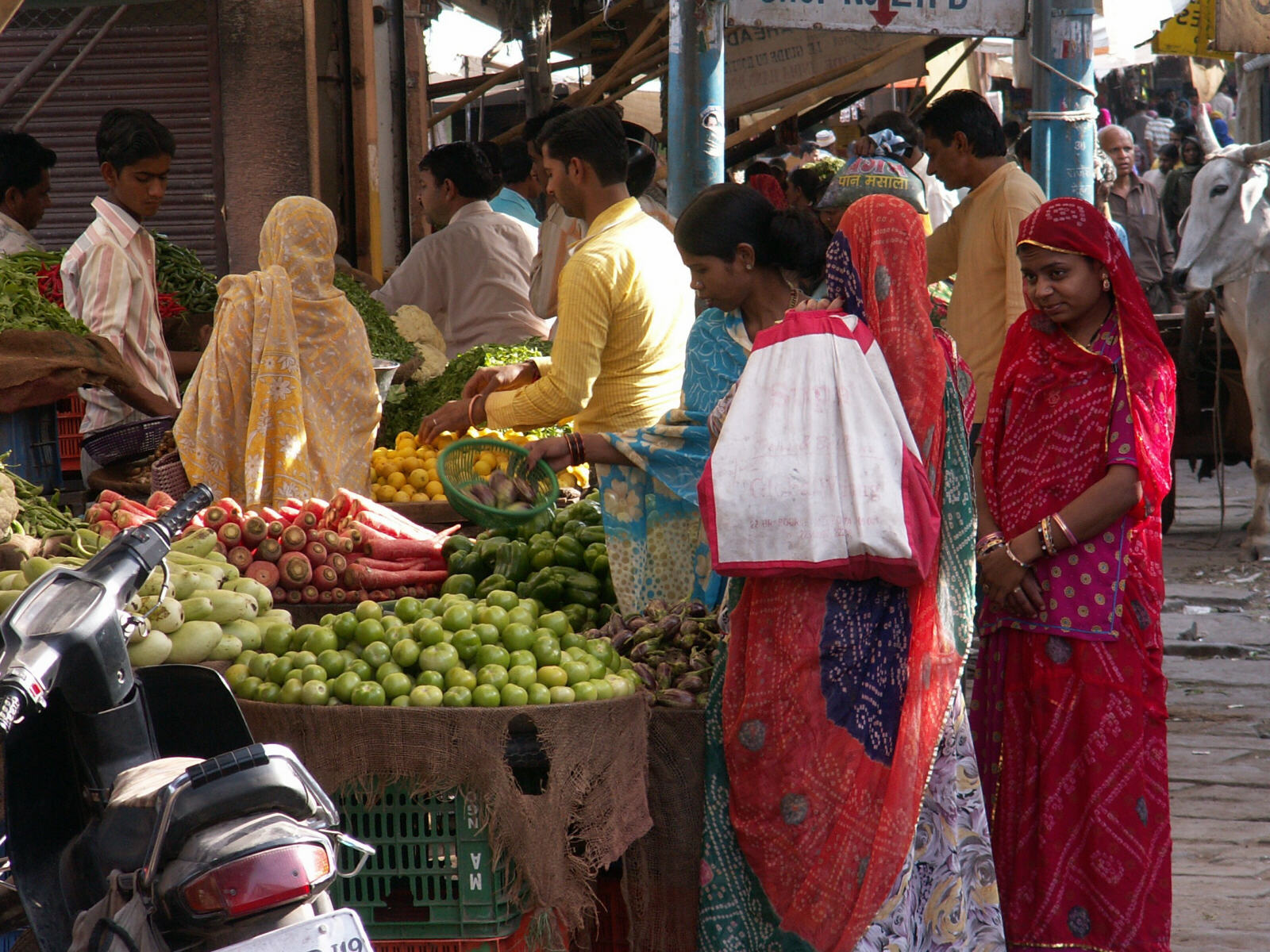 |
We visited a couple of spice shops and heard different versions of how to tell real saffron from fake (depending on the quality of the product that the particular shop was selling) and bought some that seems genuine, then walked through the grain market which is spread around another old haveli building which is being restored. We walked back through the busy streets to Singhvi's. In the evening we got an auto-rickshaw out to the Umaid Bhawan Palace, an ultra-luxurious hotel in the maharajah's extravagant former palace (he still lives in one wing). We intended to have a drink in the bar, but there is a 3000 rupees entrance fee just to get through the gate (they call it a 'cover charge') to deter sightseers and casual visitors. Disappointed we went back to the 'Bollygood' restaurant that we noticed on the way (via all sorts of other places because the auto-rickshaw driver got lost). Adjacent to the restaurant is another small palace and the owner (of palace and restaurant) showed us around the nice rooms which are now open as a hotel, the well-kept lawns and the view from the rooftops. Like most of the palaces and havelis in Jodhpur, it had been in the same family for hundreds of years. We had a very nice meal (curries, of course) in the restaurant.
Sat 24th. We walked from Singhvi's up the hill and through its series of impressive gateways into the majestic Jodhpur fort. |
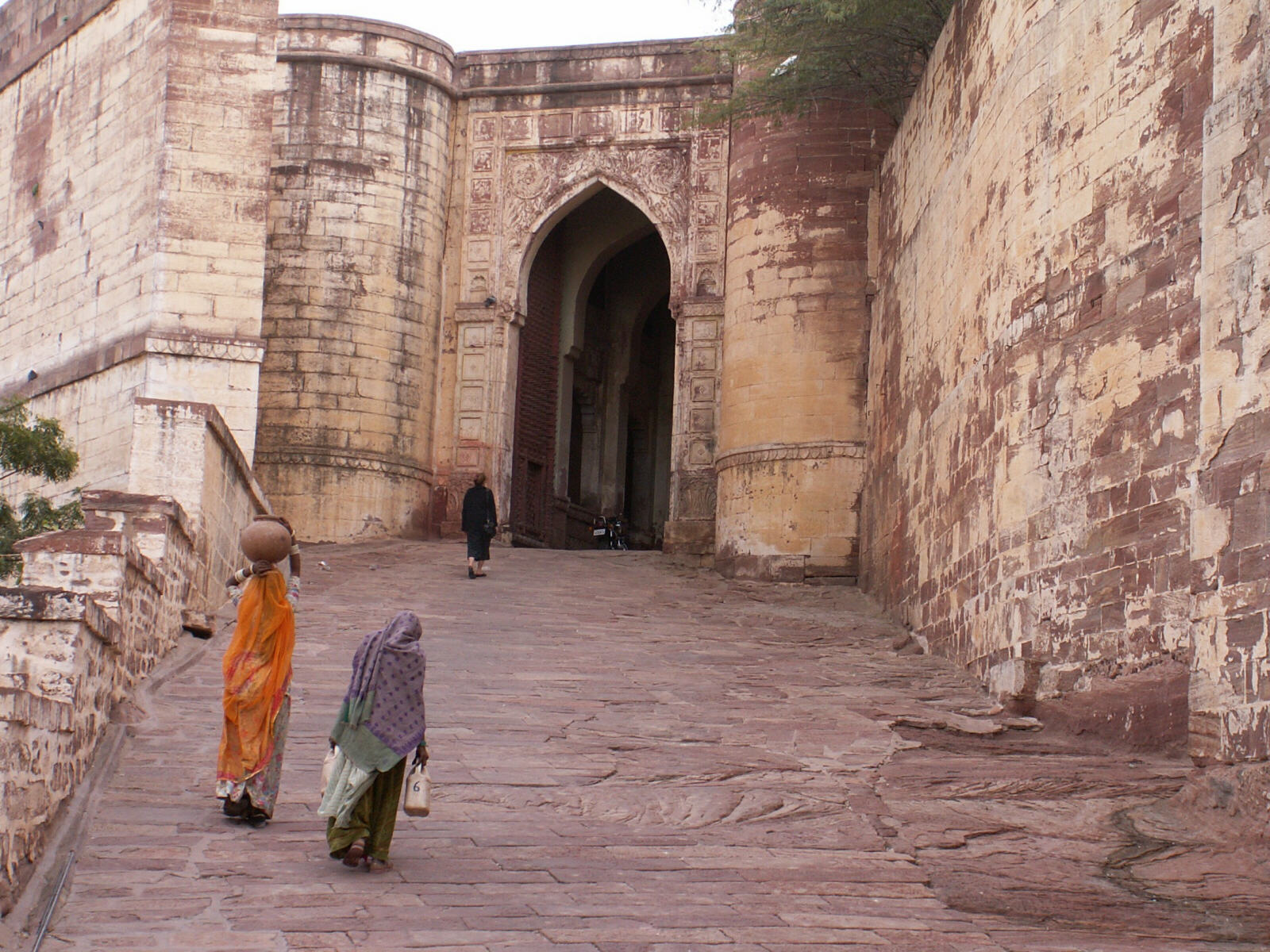 |
Inside the fort is a captivating network of courtyards and terracotta palaces with latticed windows. |
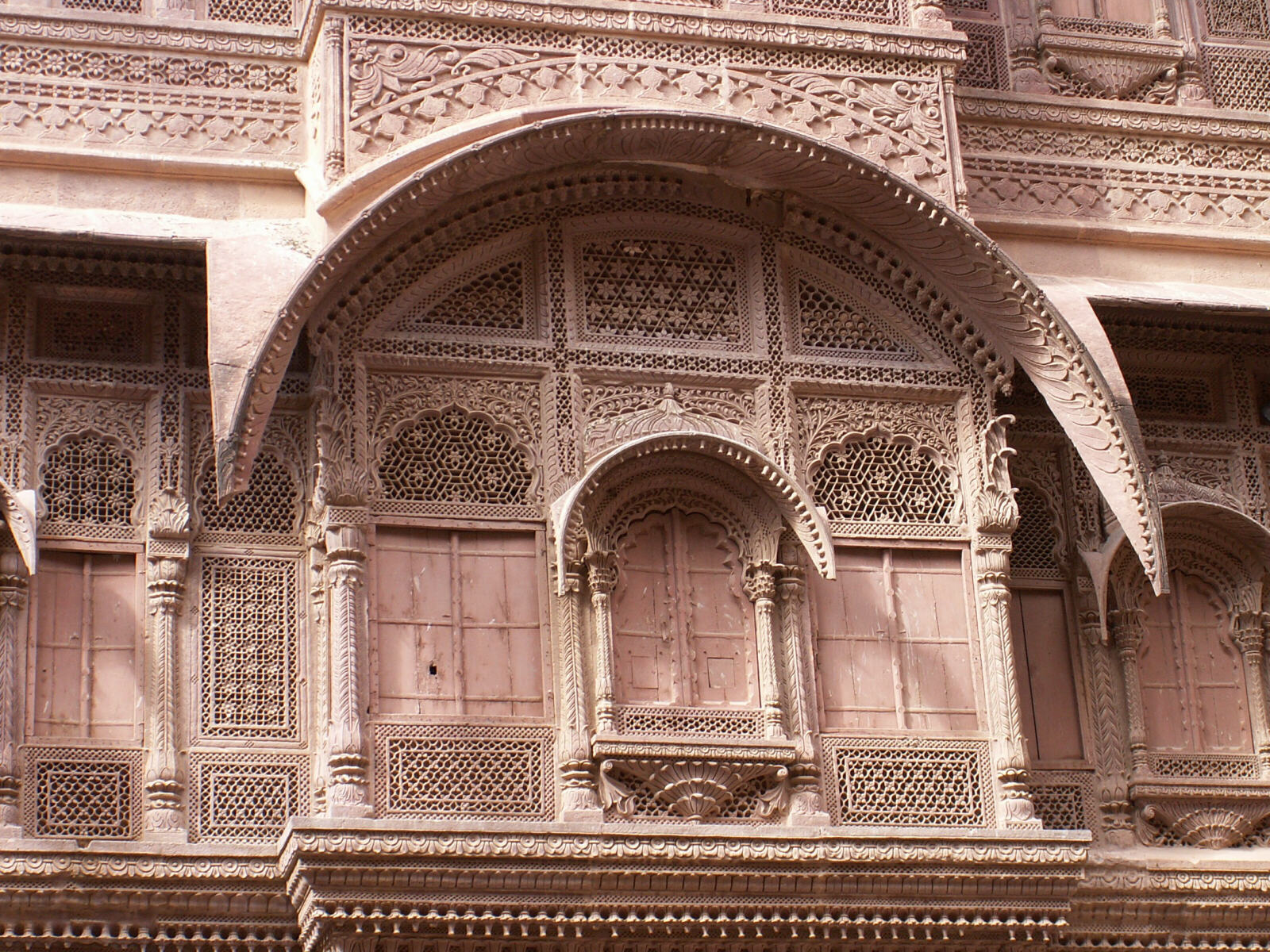 |
We cast off our prejudices and took the audio-tour, which is exceptionally well done, with interesting descriptions of 30 rooms and points of interest along the way, which you can select, start and stop in your own time. |
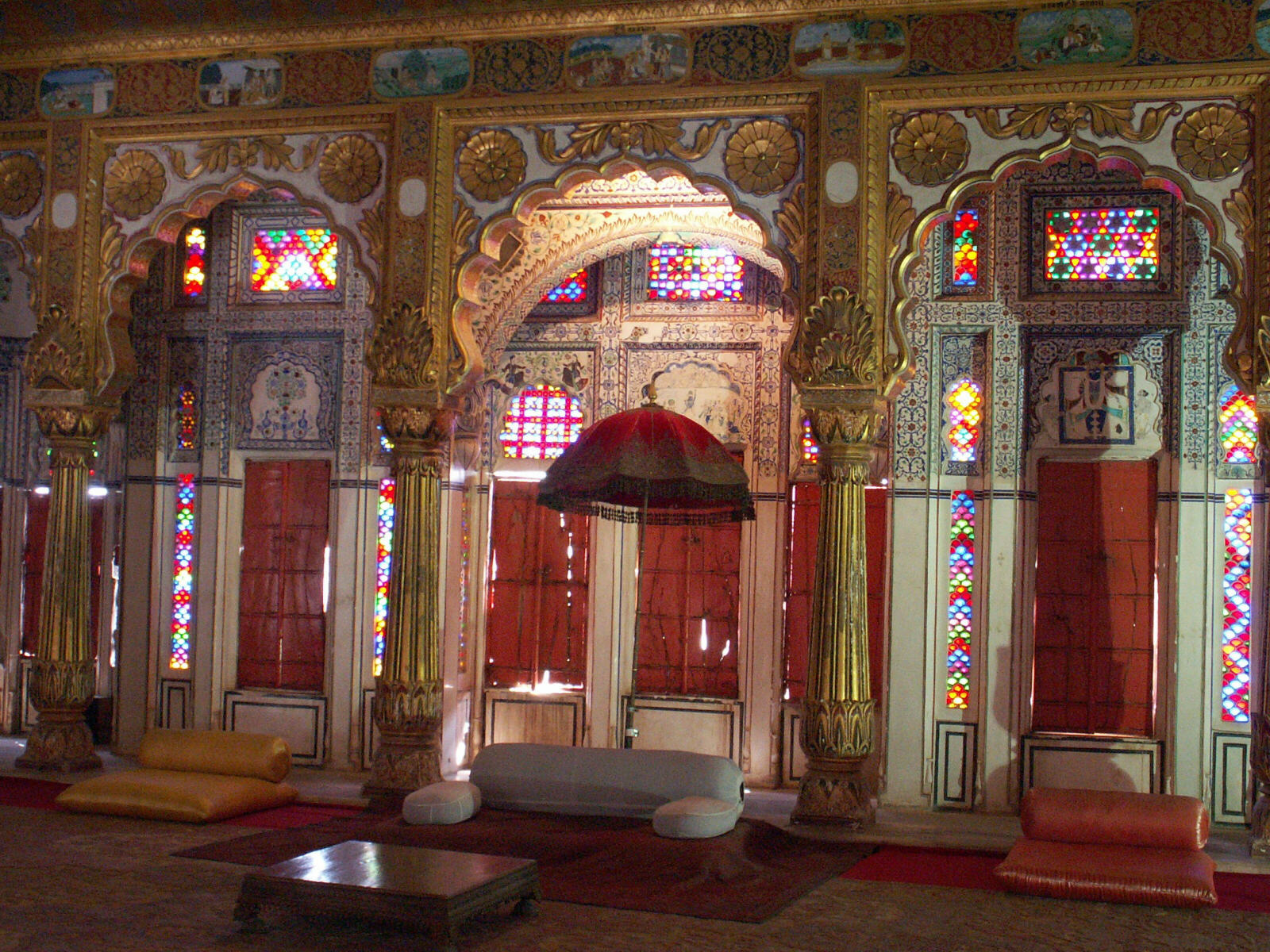 |
After the palaces we walked along the battlements to the small temple at the tip of the rock that the fort is perched on, for stunning views of the old town with its market and blue-painted houses spread out below us. |
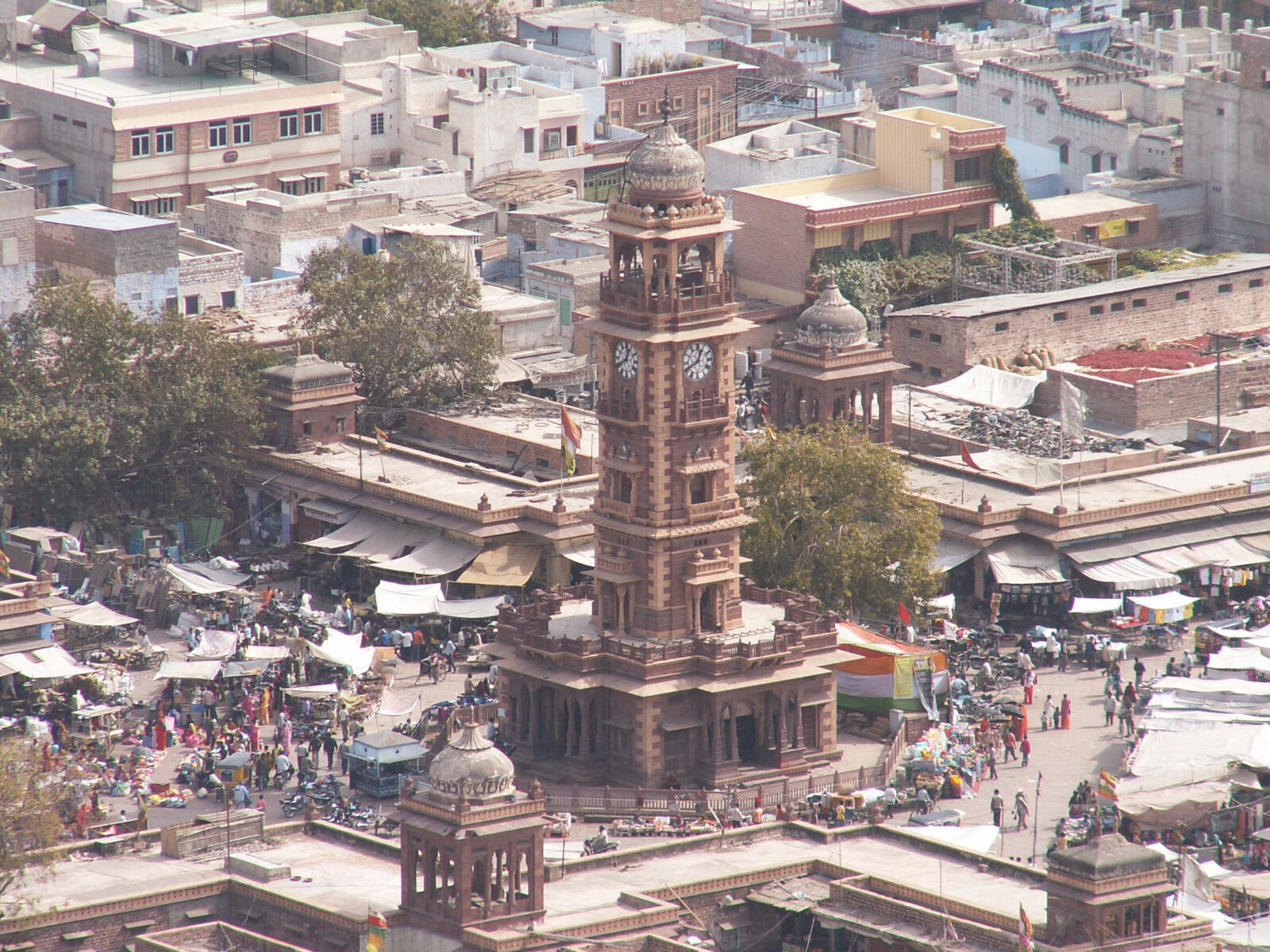 |
Originally only members of the Brahmin caste were allowed to paint their houses blue, but when the rule was abolished everyone wanted to do it! (The blue colour is also supposed to deter flies.) |
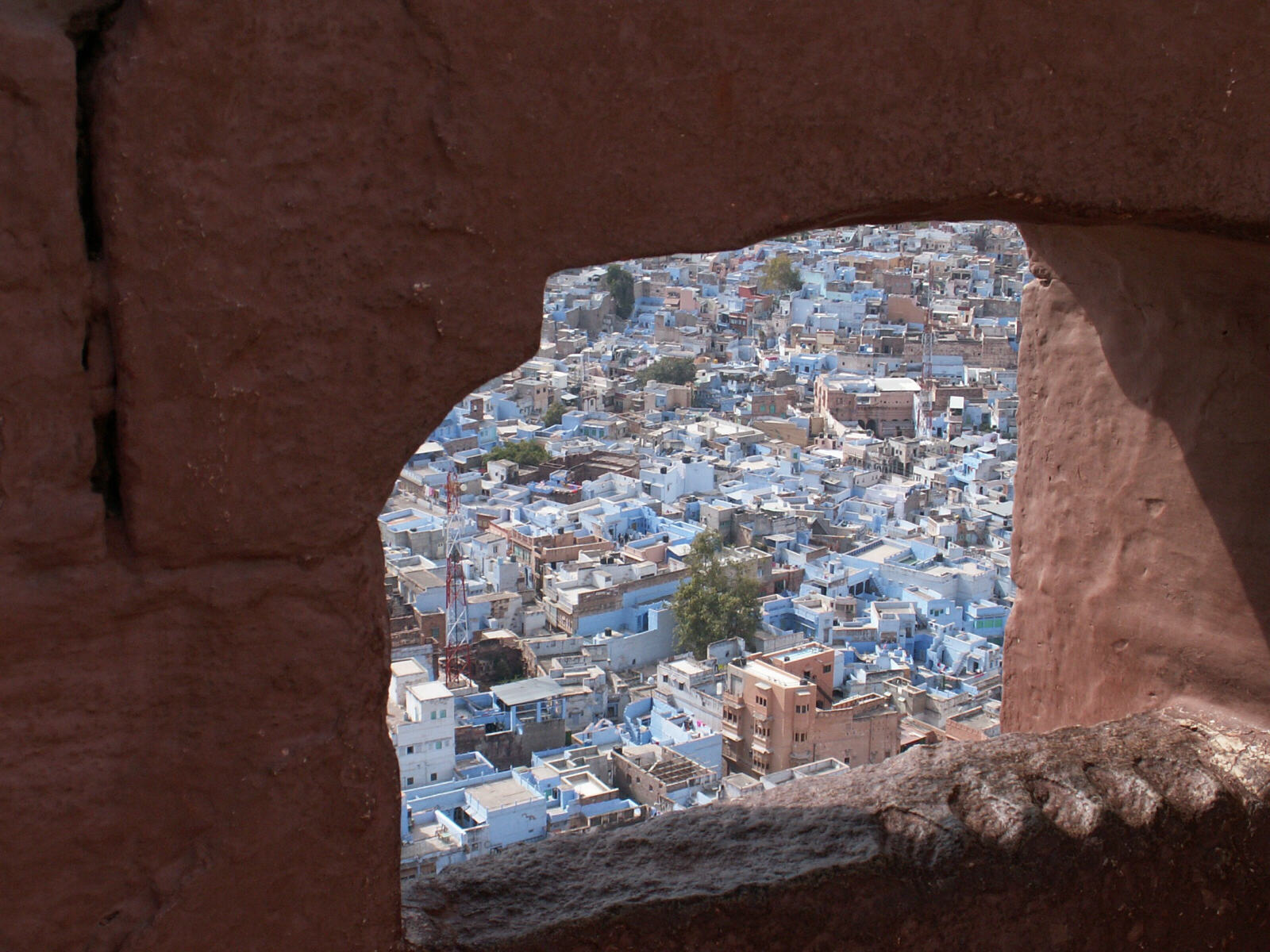 |
Altogether the fort was the highlight of the trip so far. Back at Singhvi's they recommended a fabric, arts and crafts shop in Tambaka Bazaar and showed us a back way through the maze of streets through the old town to it. Unfortunately the prices in the shop seemed very high and we found out later that, like everyone else in Jodhpur, Singhvi's get a massive commission on everything you buy if they take you there, which inflates the price you pay enormously. We walked from there up Old Fort Hill Road, looking for a rooftop restaurant that we had seen from the battlements above. We found three of them close together - Yogi's Guest House, Krishna's and Krishna Prakash Heritage Haveli. They all looked nice and we had lunch at the last one, in a shaded rooftop setting with the fort towering over us; nice curries but avoid the tomato soup! After lunch we walked back to Sardar Market round the clock tower and spent a while shopping, but mostly looking at the market and the colourful people coming and going .... |
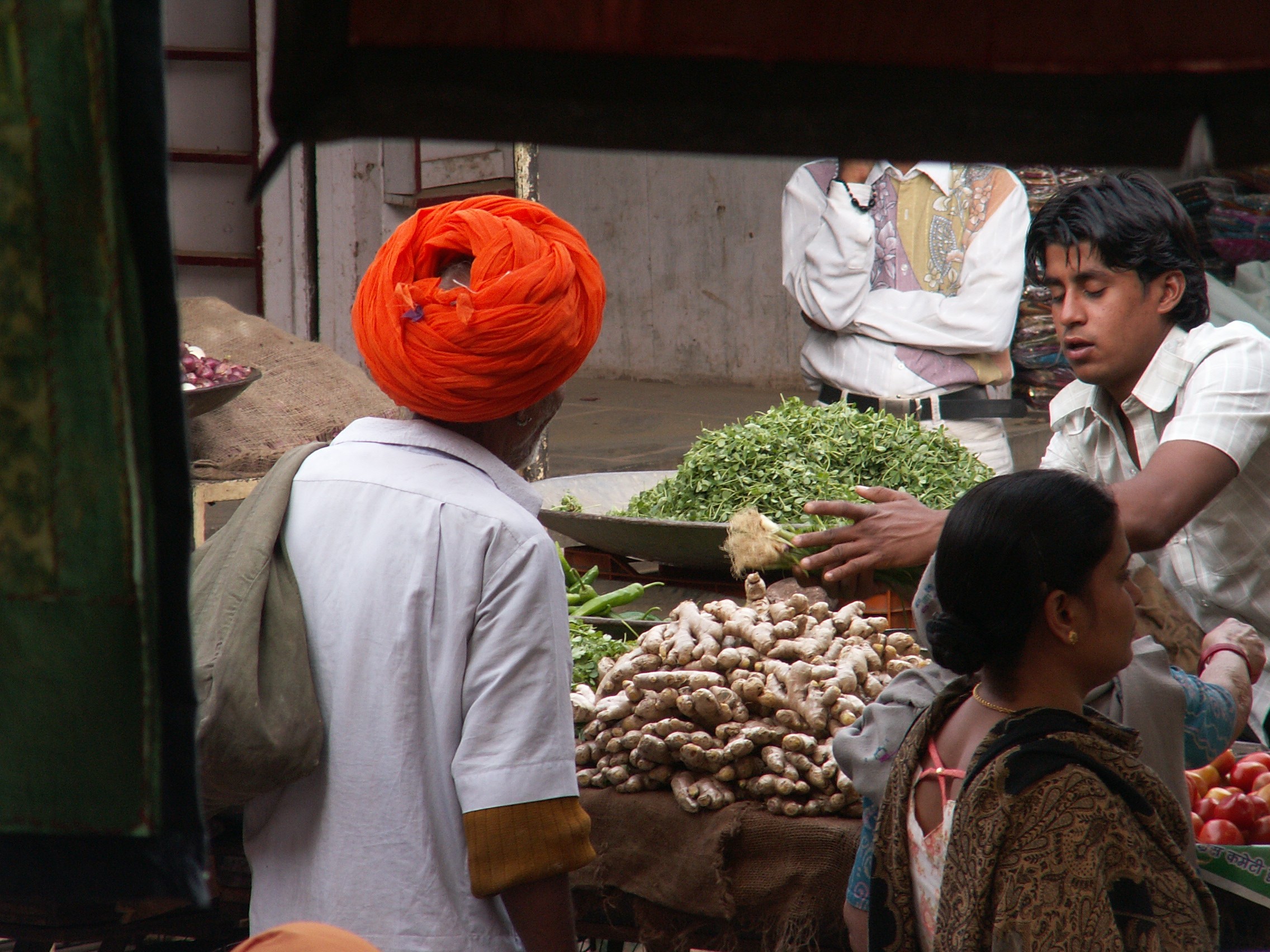 |
.... and haggling at the market stalls. |
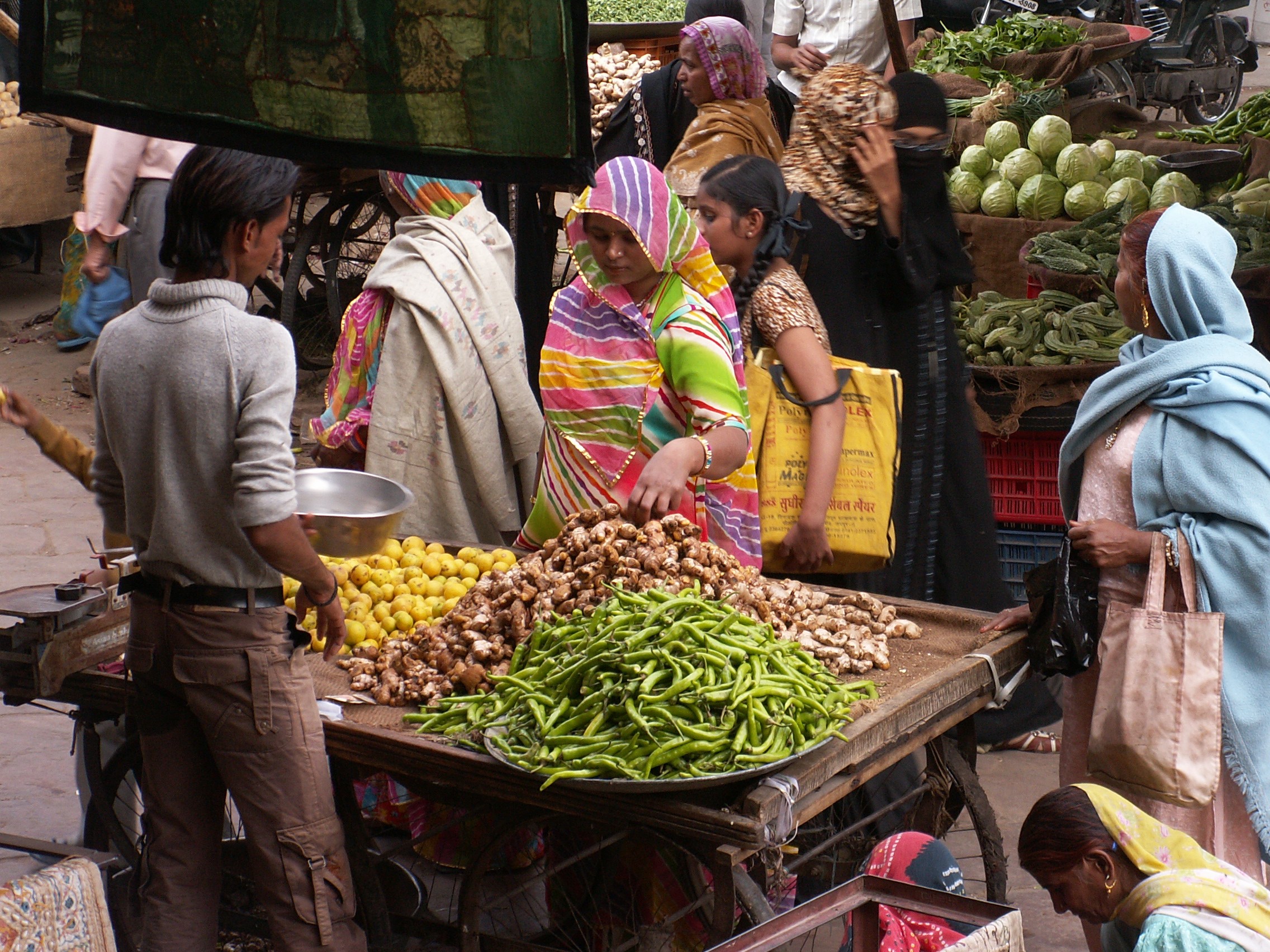 |
Waiting for a ride in Jodhpur ... |
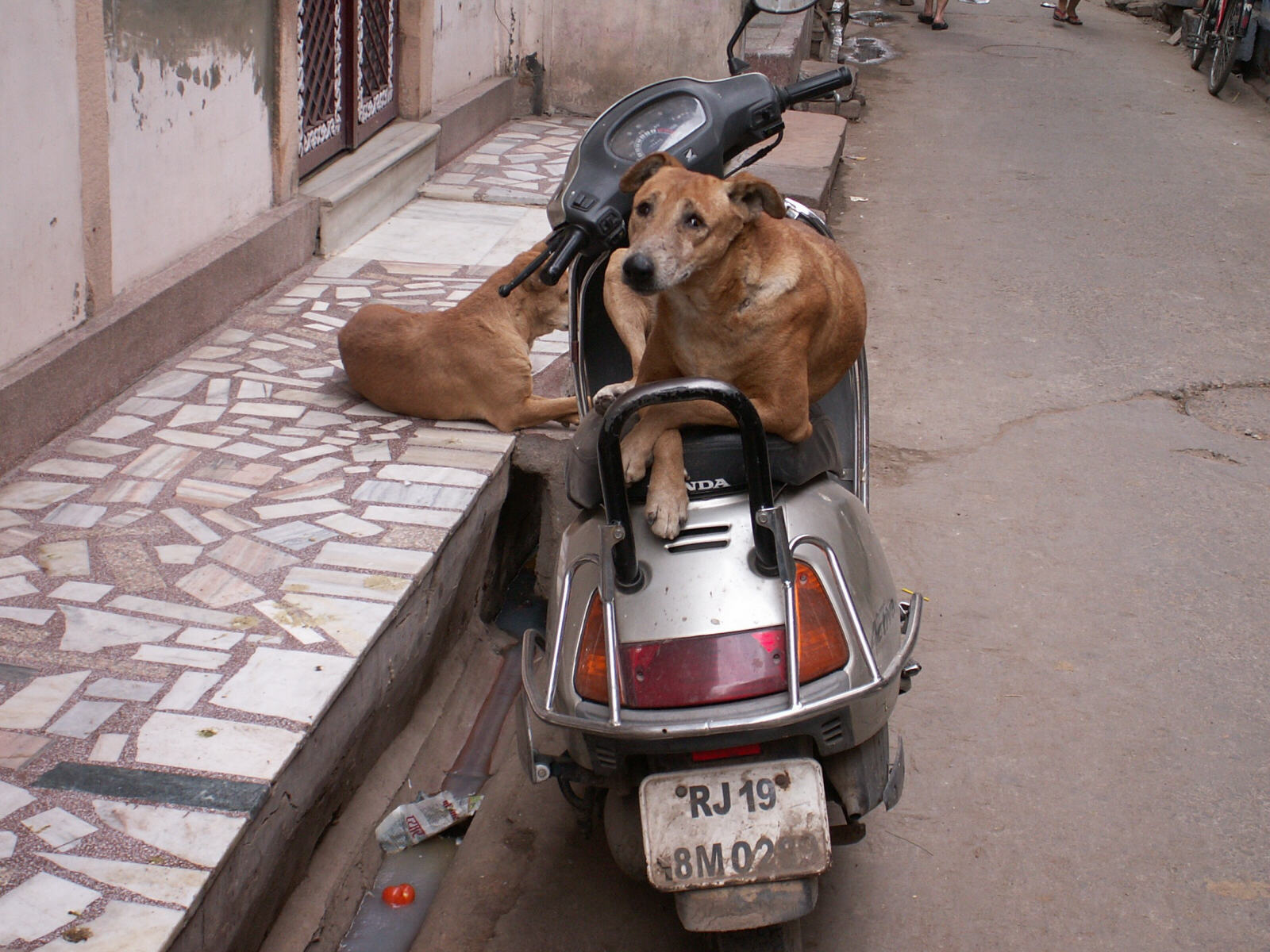 |
Eventually we got an auto-rickshaw back to Singhvi's and had a refreshing pot of tea followed by a couple of beers and dinner there, sitting cross-legged on rugs at a low table, eastern-style.
Sun 25th. As we were walking down the road from Singhvi's towards the market, we saw an elephant plodding down the road ahead of us, carrying a big pile of green plants. We followed along behind it, watching the fruit stall-holders offer it a piece of fruit (or if they didn't offer, it just took one off the barrow anyway) and various passers-by give it presents of sugar lumps or fruit. It turned into a small temple just off the bazaar, where they unloaded the greenery and it plodded off down another small alleyway. |
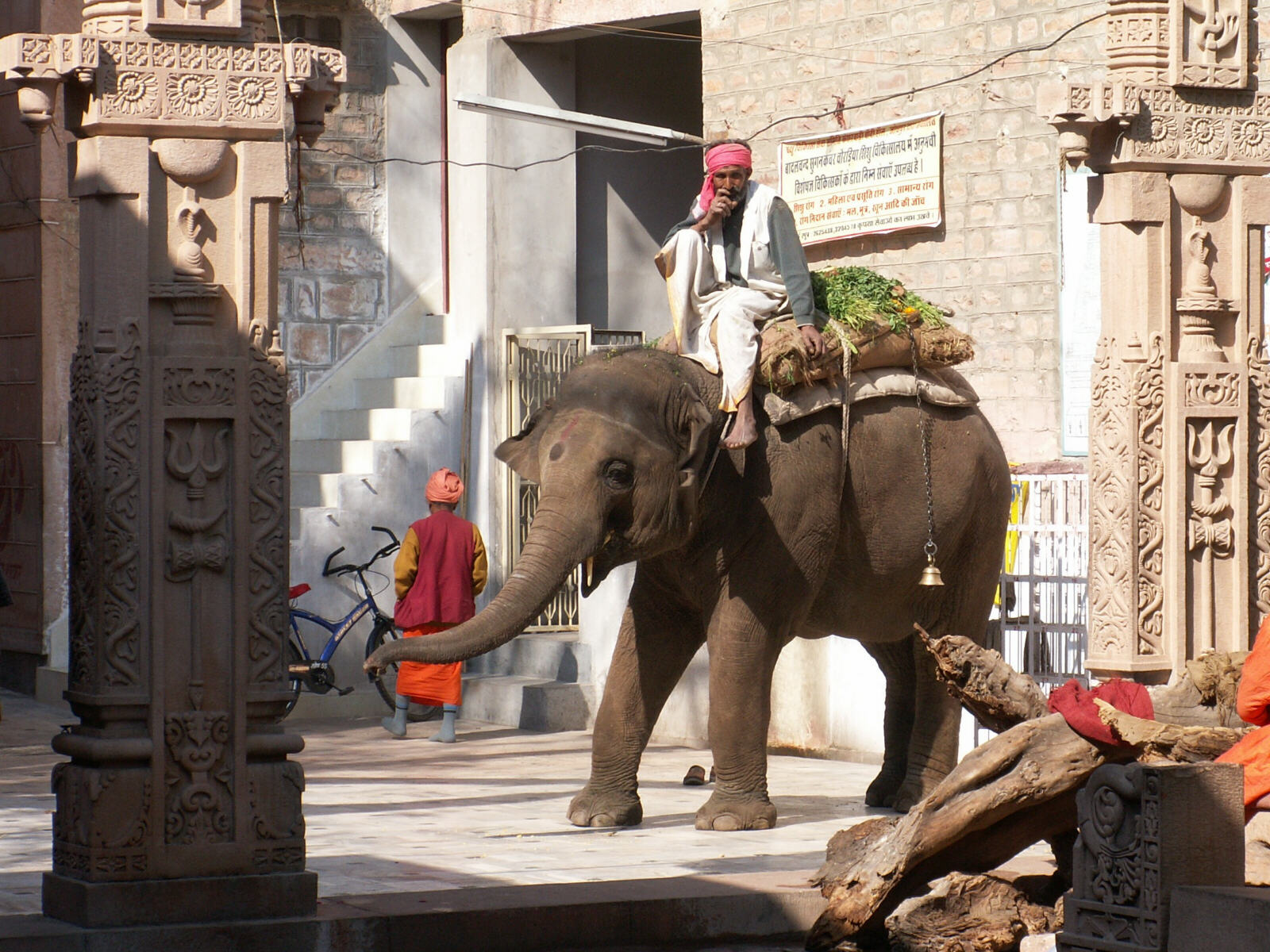 |
We met another traffic hazard in a Jodhpur street. |
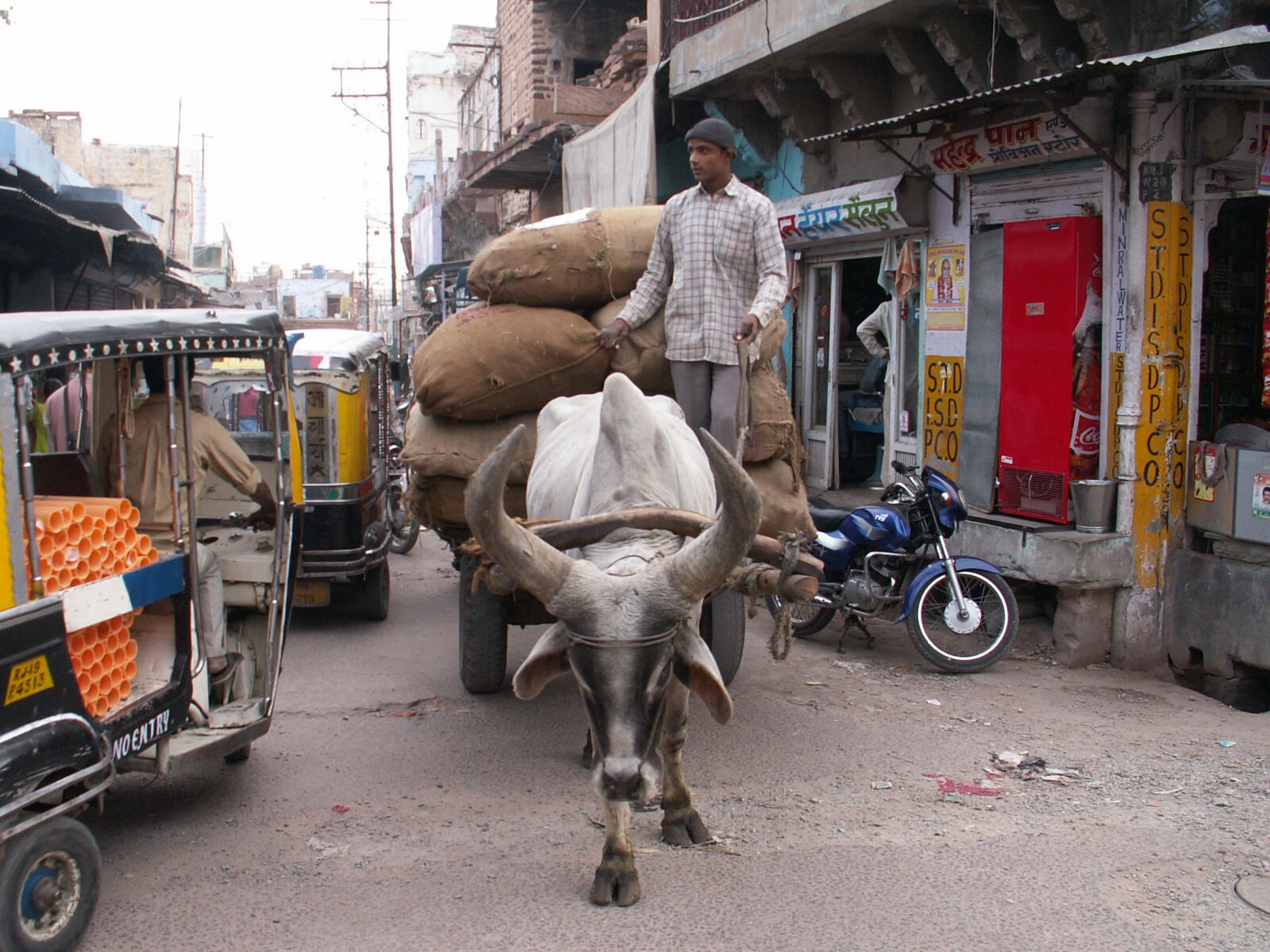 |
We went on to the clock tower and spent a while watching the fascinating crowds drifting through the market, then went to Umaid Heritage Art School in the grain market where Sheila spent a pleasant half hour going through the full bargaining ritual with Vijay, the very friendly proprietor, for a lovely colourful elephant painted on a piece of carved, polished camel bone, while I sipped tea. We got an auto-rickshaw, complete with the driver's wife on her way home, back to Singhvi's where we had arranged to meet Sajjan, the driver to take us on a trip to Osiyan, a town 60 km out into the desert. He had phoned and left a message that he could not get the car up the narrow streets (as we rather expected) and he would meet us at the Jalori Gate at the edge of the old town. When we got there he was nowhere to be seen so we asked around and a passer-by called him on his mobile. It seemed he was waiting in another square on the other side of the gate, so we went there while, apparently, he came around for us! Eventually we met up and set off, with his young son in the front seat along for the ride. |
- Osiyan |
First we went to Mandore Gardens, a former capital city of the local princedom, where there were several old temples and a museum all set in well-kept gardens. The place was obviously a favourite weekend day out and was full of local people strolling around or playing cricket on the grass, or watching the numerous monkeys sitting on the walls, who didn't seem too worried by the crowds around them. |
 |
Then we set off to Osiyan, a small town at the edge of the desert, where the highlight was two Jain temples, both frequented by large numbers of pilgrims. Sachiya Mata temple was quite elaborate and built on a small hill overlooking the dunes. |
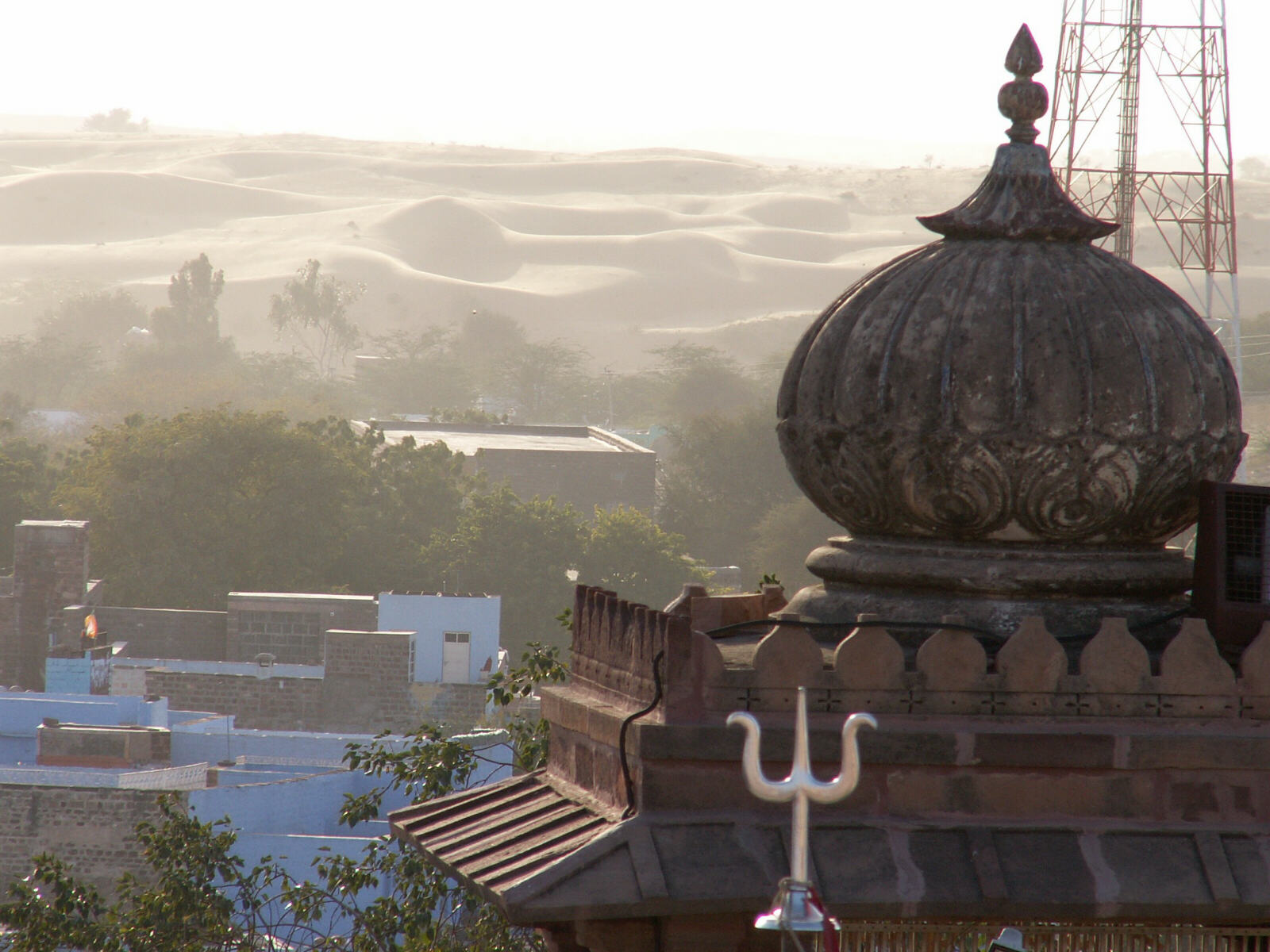 |
Mahavira temple was very peaceful and pretty, with beautifully-restored carvings. The proprietor/priest proudly showed us one of the small temple buildings which he, his father and his son had spent years carving as a faithful replica of the ancient one next to it. Finally we went to the big sand dunes on the edge of town where large crowds were standing on top of the dune watching the sunset that we had just missed, while kids played at rolling all the way down the dune in the sand. When we got back to Jodhpur Sajjan dropped us at 'On the Rocks', a very nice and popular garden restaurant with wood-burning heaters between the tables, owned by the same man as 'Bollygood', where we had yet more wonderful curries. |
- Jaisalmer |
Mon 26th. Reluctantly we departed from the wonderful Maharani suite, one of the best rooms we had stayed in, and got an auto-rickshaw down to the private bus station by Bombay Motors Circle. There's an hourly bus to Jaisalmer and we got on the 11 o'clock which was half sleeper bus and half normal seats. Above the seats were sleeping compartments, singles down one side and doubles on the other, but the Indian people used the double compartments as little gathering places, with up to six of them sitting cross-legged and chatting in each one. We had allocated seat numbers, me sitting (180 Rs) and Sheila in a single sleeper (300 Rs) and it was very comfortable as we set off at a good pace past the sand dunes across the 300 km of semi-desert to Jaisalmer. From time to time the bus stopped and more people got on, until there was a whole community sitting along the aisle, but no-one encroached on our seats and it remained an interesting, comfortable ride. |
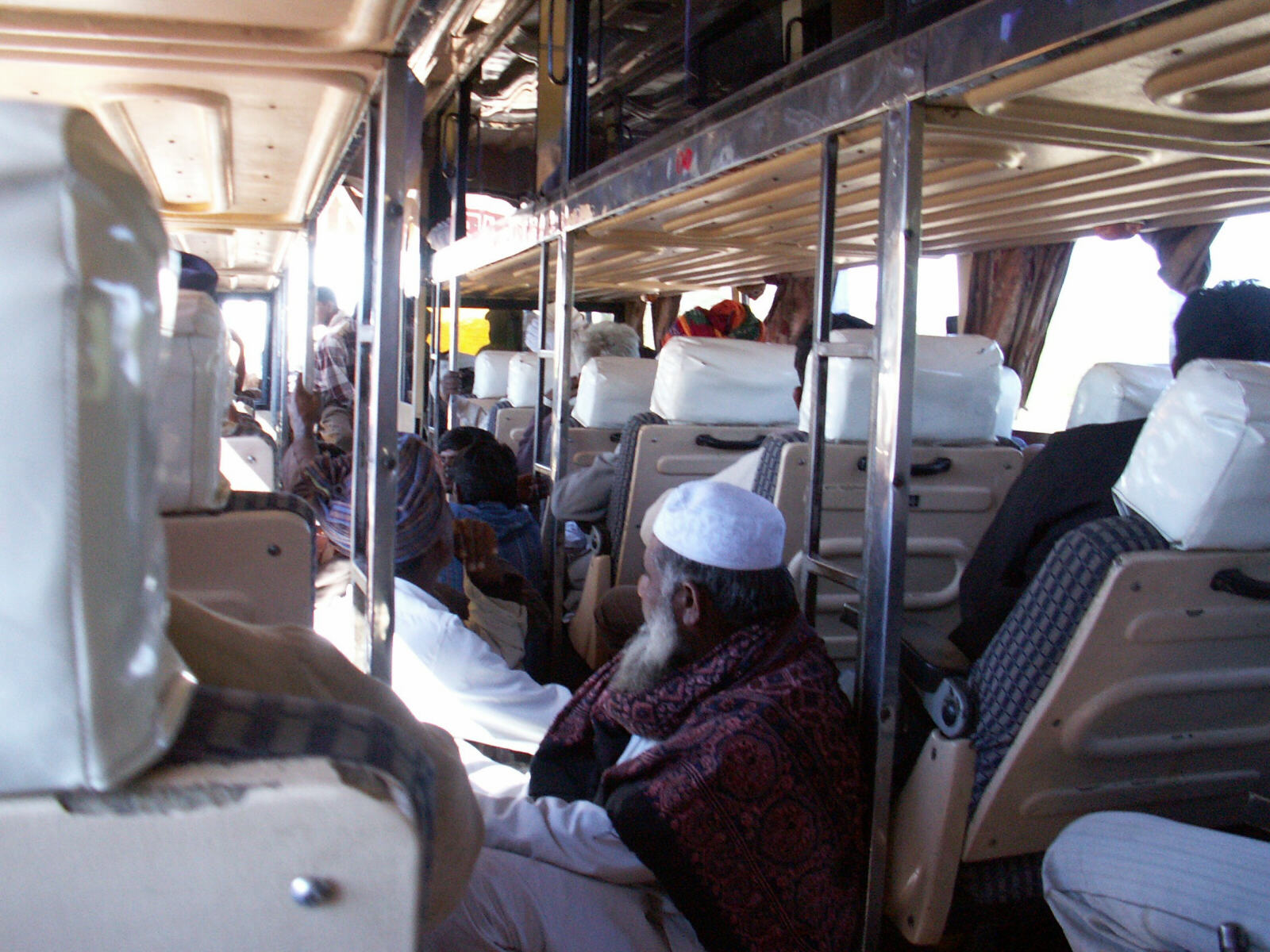 |
When we arrived in Jaisalmer we were besieged by auto-rickshaws and hotel 'representatives' and were persuaded to have a look at 'Pol Haveli' which is in a new stone building with very clean, nicely furnished rooms although it's a little way away from the centre of the old town. We stayed in the best room in the house, spacious with nice solid wooden furniture, the mandatory fort view from the window, a wall hanging which Sheila ended up buying for our summer house at home and, the most exceptional feature, an actual bathtub instead of a shower! With luxury like that we could not resist! We strolled along the interesting walk into town, past camels tied up in back yards and cows grazing by the street, to Gandhi Chowk, the bustling main square, and along the interesting main bazaar as far as the first gate to the fort. We wandered back as it got dark, and went into Trio restaurant, a very nicely-presented rooftop restaurant with stunning views of the floodlit fort, resident musicians to serenade you with Indian music, and yet more wonderful food!
Tues-Thurs 27th-29th. Sightseeing in Jaisalmer. We went into Jaisalmer fort .... |
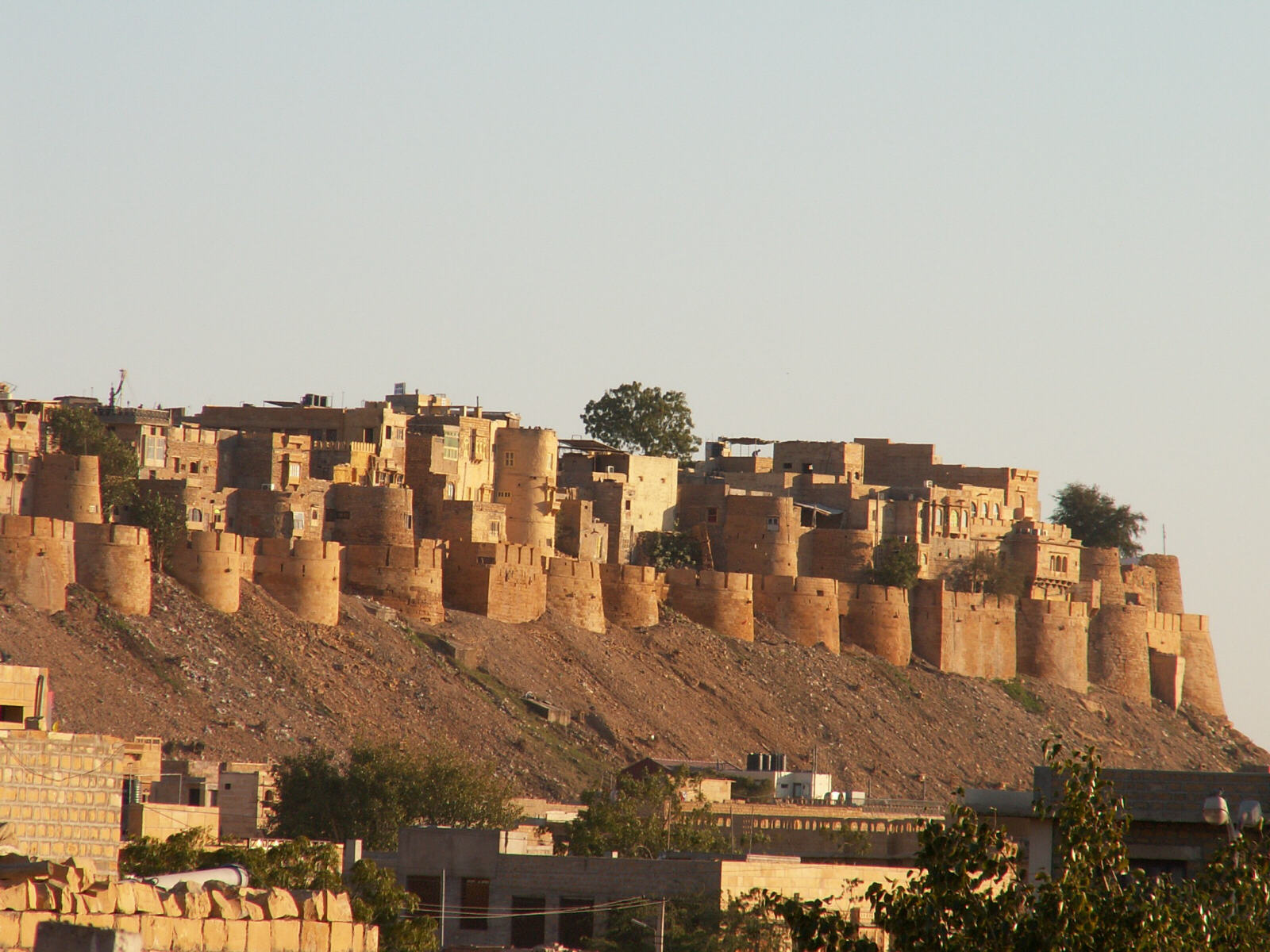 |
.... through impressive gates and courtyards .... |
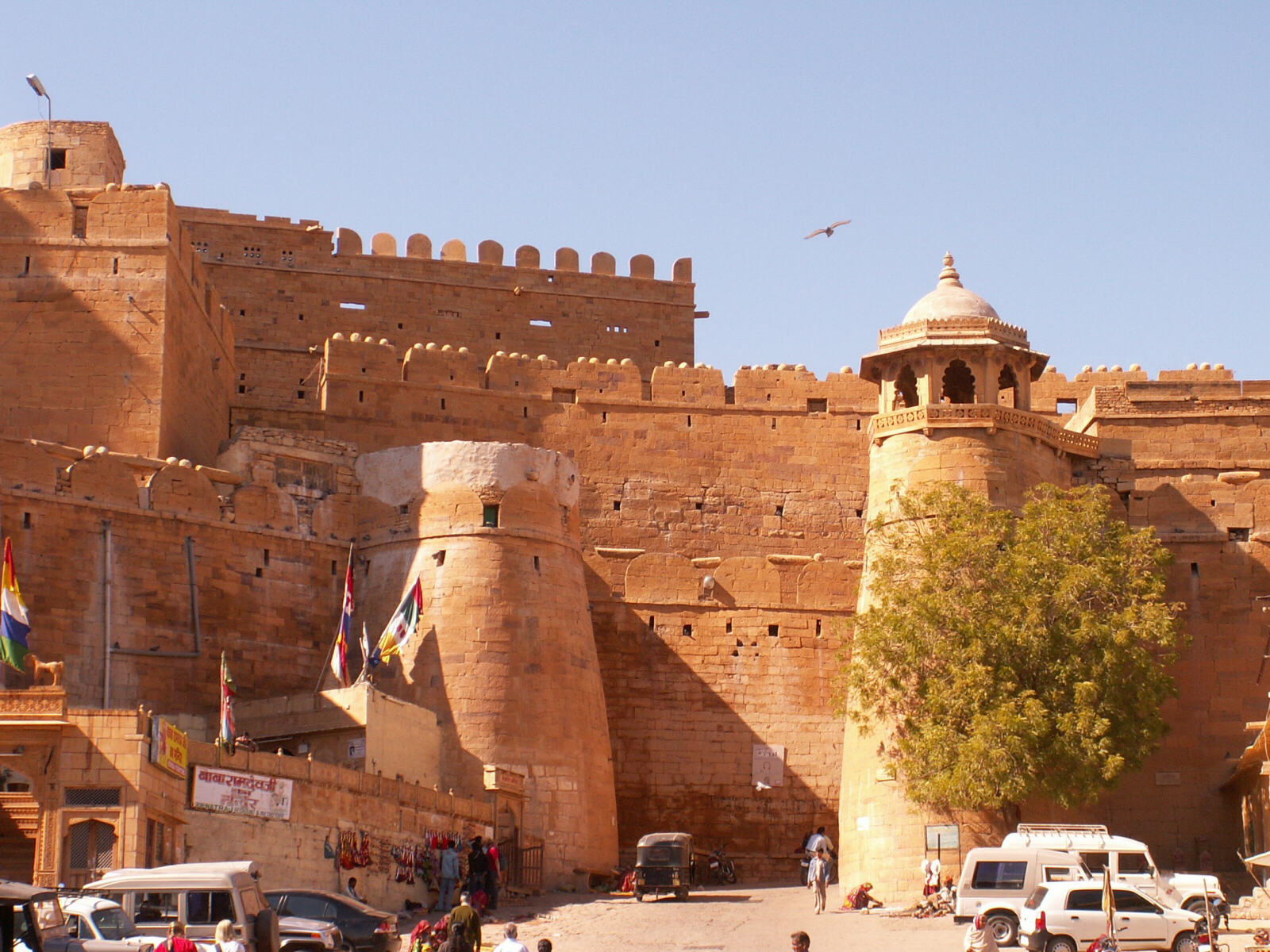 |
.... and did the tour of the palace in the fort, which was smaller and less impressive than the one in Jodhpur but still fascinating and with great views of the fort's bastions and the town around. |
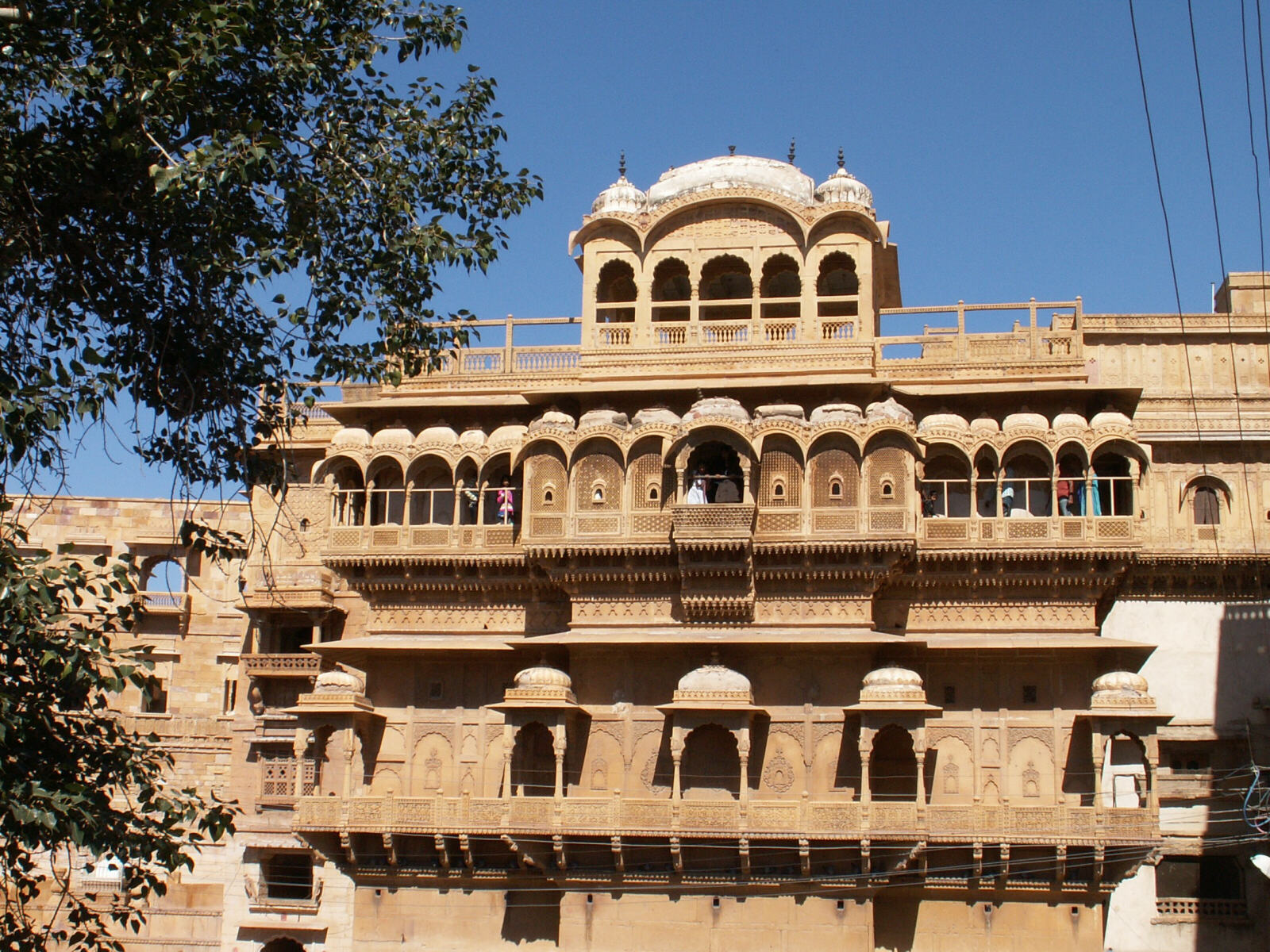 |
We had lunch in the Indian/Australian 8 July restaurant in the square beneath the palace, either a snack of delicious pure mango pulp and a vegemite toast or spicy potato snacks with the owner's special coriander chutney. We walked all round the warren of narrow streets and squares inside the fort, enjoying the sandstone-built temples, houses, guest-houses, beautifully-kept hotels built into the fort walls, colourful fabric and handicraft shops and the occasional view from the battlements. Jaisalmer fort has a whole town inside its walls, unlike Jodhpur which has the incredible palace but few other buildings. We had a genuine Italian espresso at the 'Om' Italian restaurant and had a very interesting chat with the owner, a member of the Brahmin caste whose name was in fact 'Om'! Even though he was a Brahmin and committed to not hurting any living thing, he said he would gladly get rid of the dogs that bark all night! We continued back to the fort entrance, browsing in various fabric shops and book shops on the way.
We walked through the old city outside the fort and detoured from the bazaar to see two of the old havelis, elaborately-carved stone houses of former ministers and merchants. Nathmal Haveli was built by two brothers who built one wing each and although it looks symmetrical, there are many small differences of detail, and the man who sells postcards outside and spends all day sitting looking at it, pointed them all out to us! Zig-zagging through the back streets we arrived at Patwa Haveli, the most elaborate building in town after the actual maharajah's palace, which was built in the early 1800s by five Jain brothers who were merchants in the opium trade, and which towers impressively over the narrow lane below. |
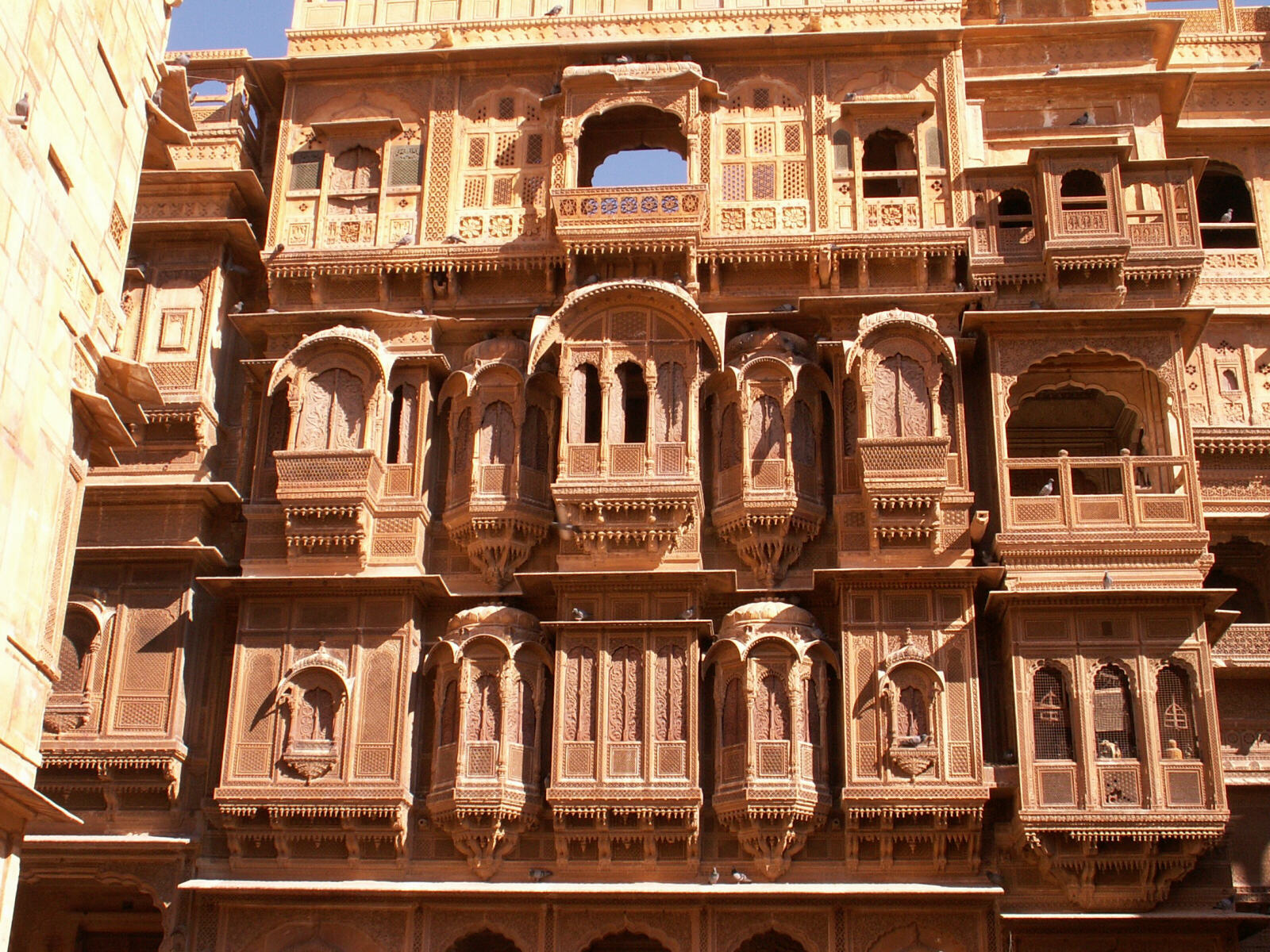 |
On the way back to our haveli we bought a bag of carrots from a stall and fed them to some of the many cows who were wandering along the streets or sunning themselves in the square. Despite the carrots the cows seemed to take a dislike to Sheila for some reason, and she was the victim of several unprovoked attacks as they tried to head-butt her if she came too close, and one with horns connected leaving quite a bruise! |
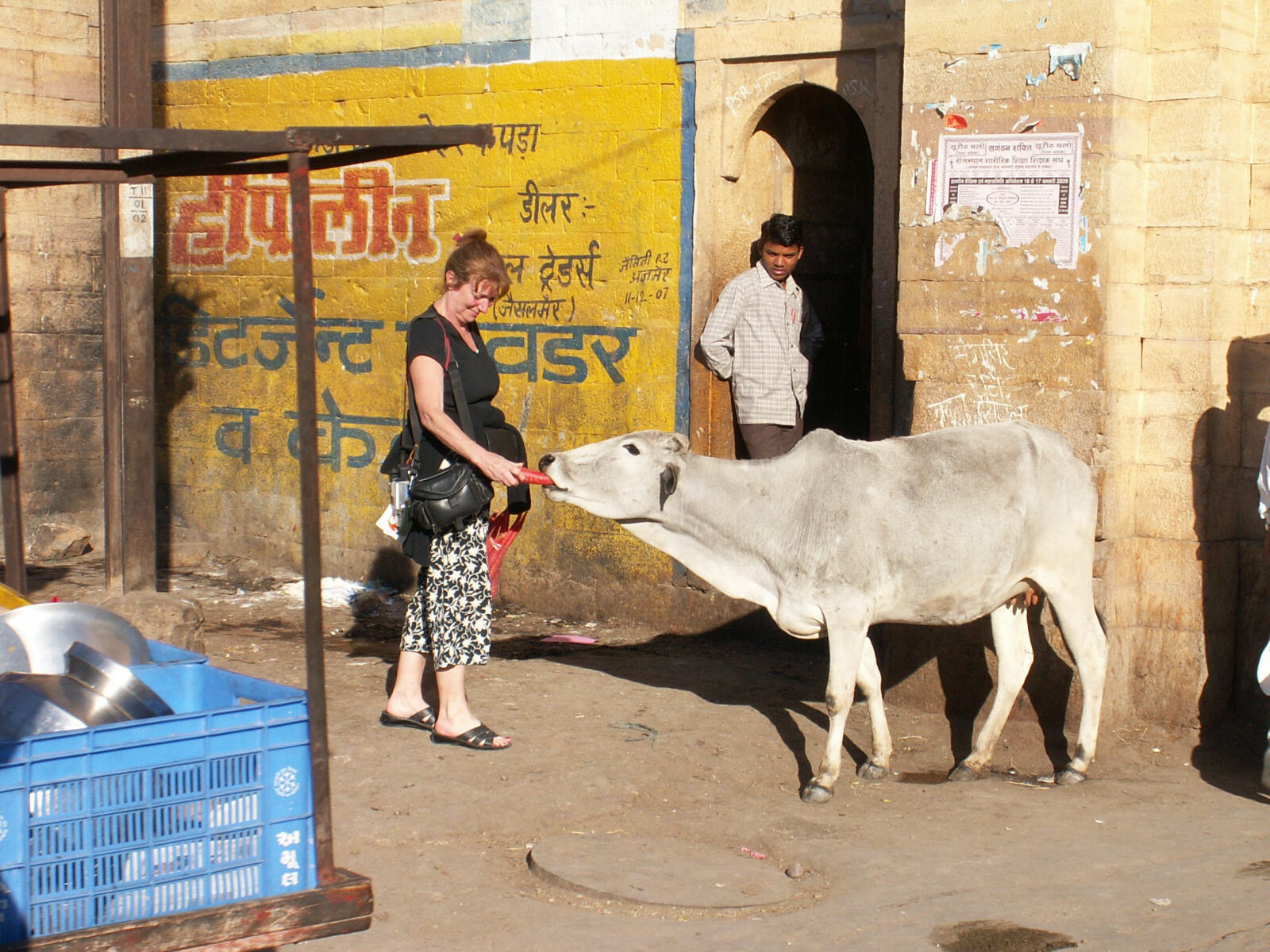 |
Each evening, predictably, we had another excellent meal with a view of the fairy-tale fort and palace at the Trio restaurant. |
- Bikaner |
Fri 30th. We had another lunch at 8 July restaurant, a great place to relax and observe the hustle and bustle in the square below as tourists, touts, auto-rickshaws and shopkeepers flow to and fro. Then we caught the 2pm 'sleeper' bus to Bikaner and had a cozy double sleeping compartment. When we arrived about 9pm the people from the Harasar Haveli hotel were there to meet us, as arranged by their friends in the last hotel. Harasar Haveli is modern and clean and the rooms are good value, but it is some way away from the points of interest in the town.
Sat 31st. We went and did the tour of the very impressive and picturesque palaces inside Bikaner fort, with interconnecting courtyards, balconies, kiosks and towers, with beautifully-decorated and furnished interior rooms. The tour progresses in sequence from the earliest 16th-century palace up to the rooms, furniture and even office equipment used by the Maharajah in the 1930s. Sheila also went into the museum of royal sarees which she enjoyed, while I had a tea at the café outside. It was a very interesting tour. |
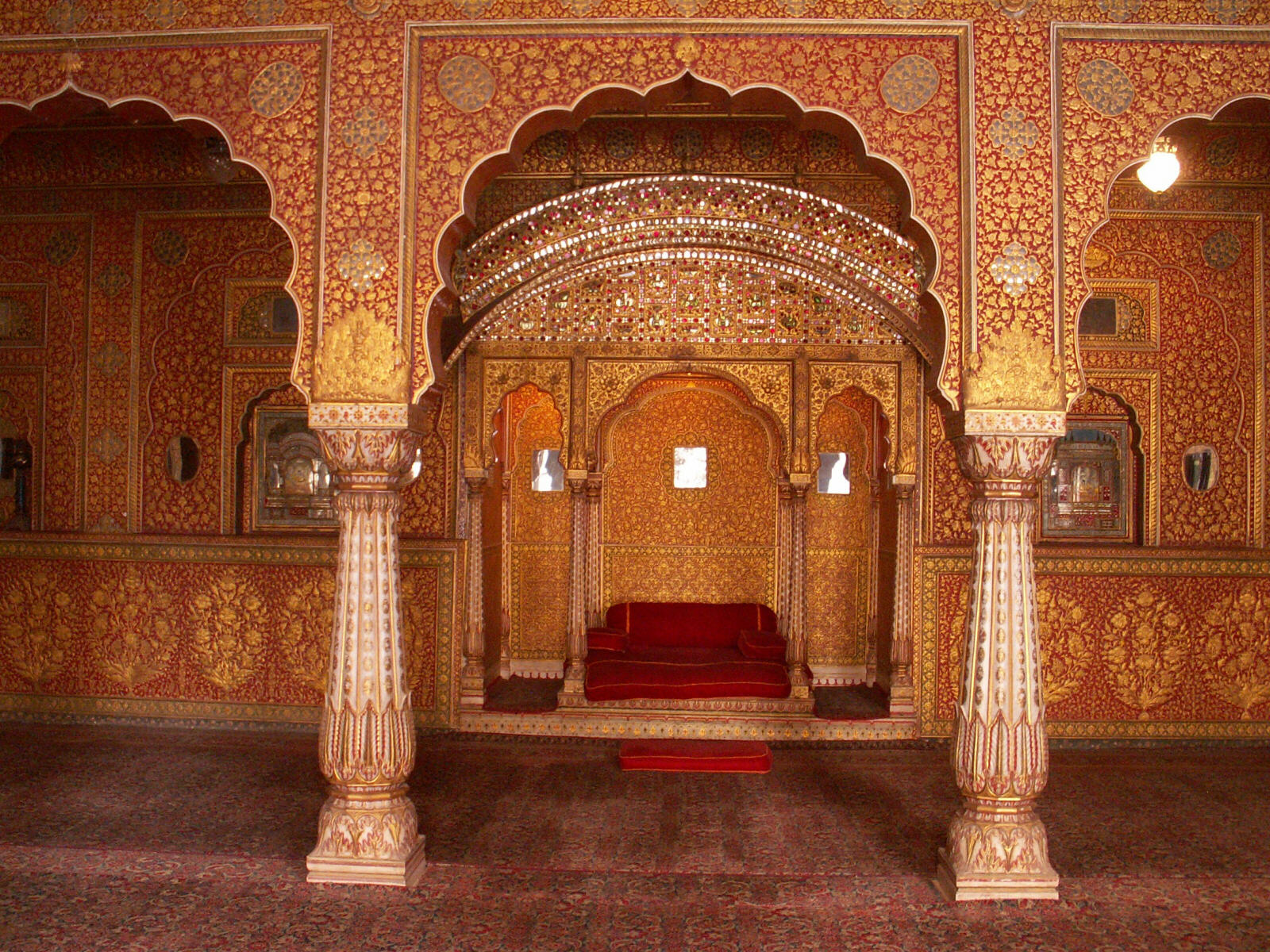 |
In the afternoon I walked to and through the old city, with its narrow winding streets and far-flung points of interest. There are havelis, markets, Jain temples and bazaars, but they are scattered over a wide area and it is a trek to see them all. Along the road, camel carts loaded with full sacks kept plodding by. |
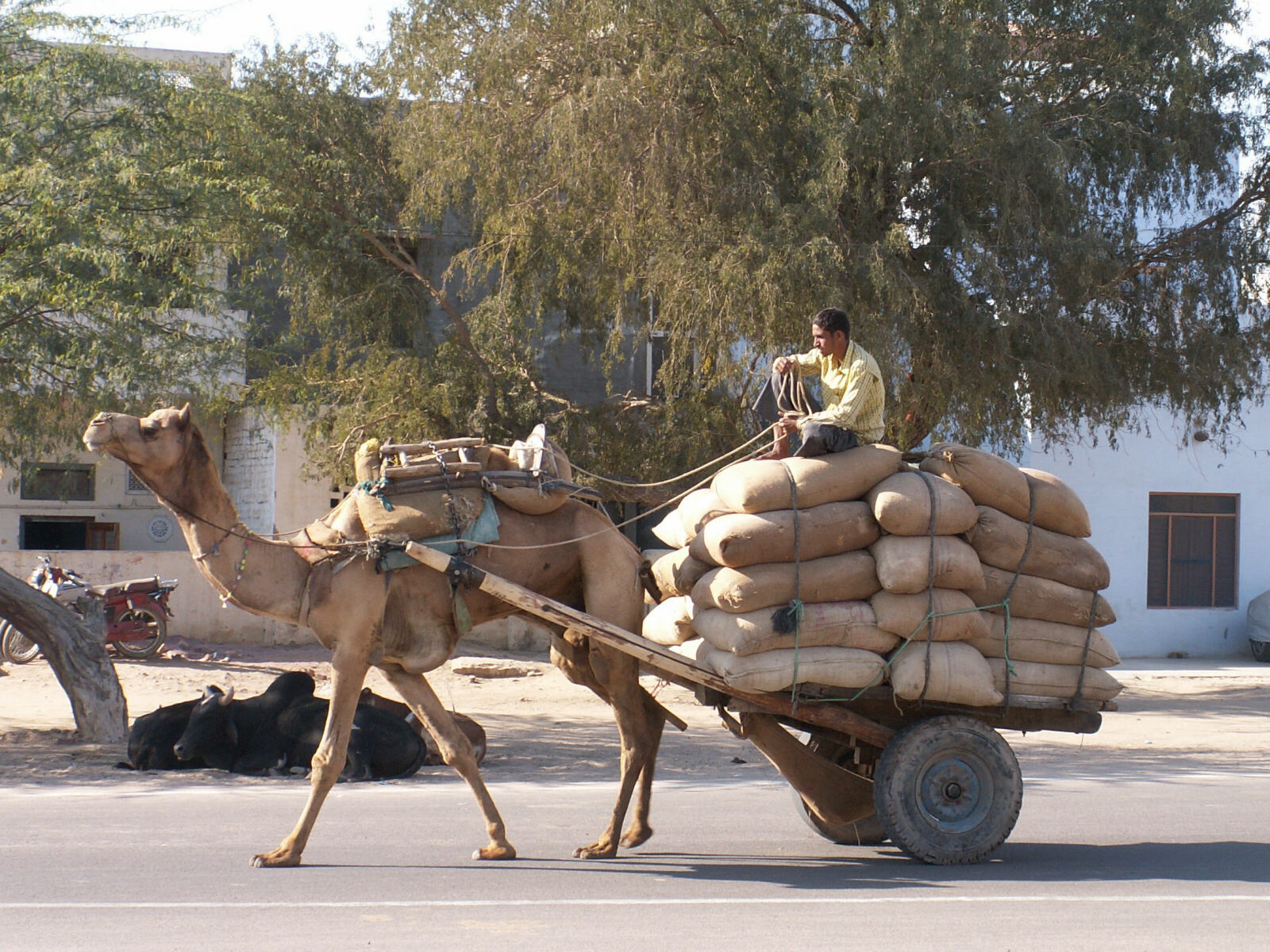 |
Rather than venture back out into the city we had a very nice dinner at the Harasar Haveli.
Sun 1st Feb. We went by car 30 km outside Bikaner to the amazing Temple of the Rats. In a country full of weird things, this is one of the weirdest; the legend is that in a dispute between two gods, one of them reincarnated all the dead story-tellers as rats, to deprive the other god of their souls. The temple was full of colourfully-dressed pilgrims and worshippers giving food to the rats .... |
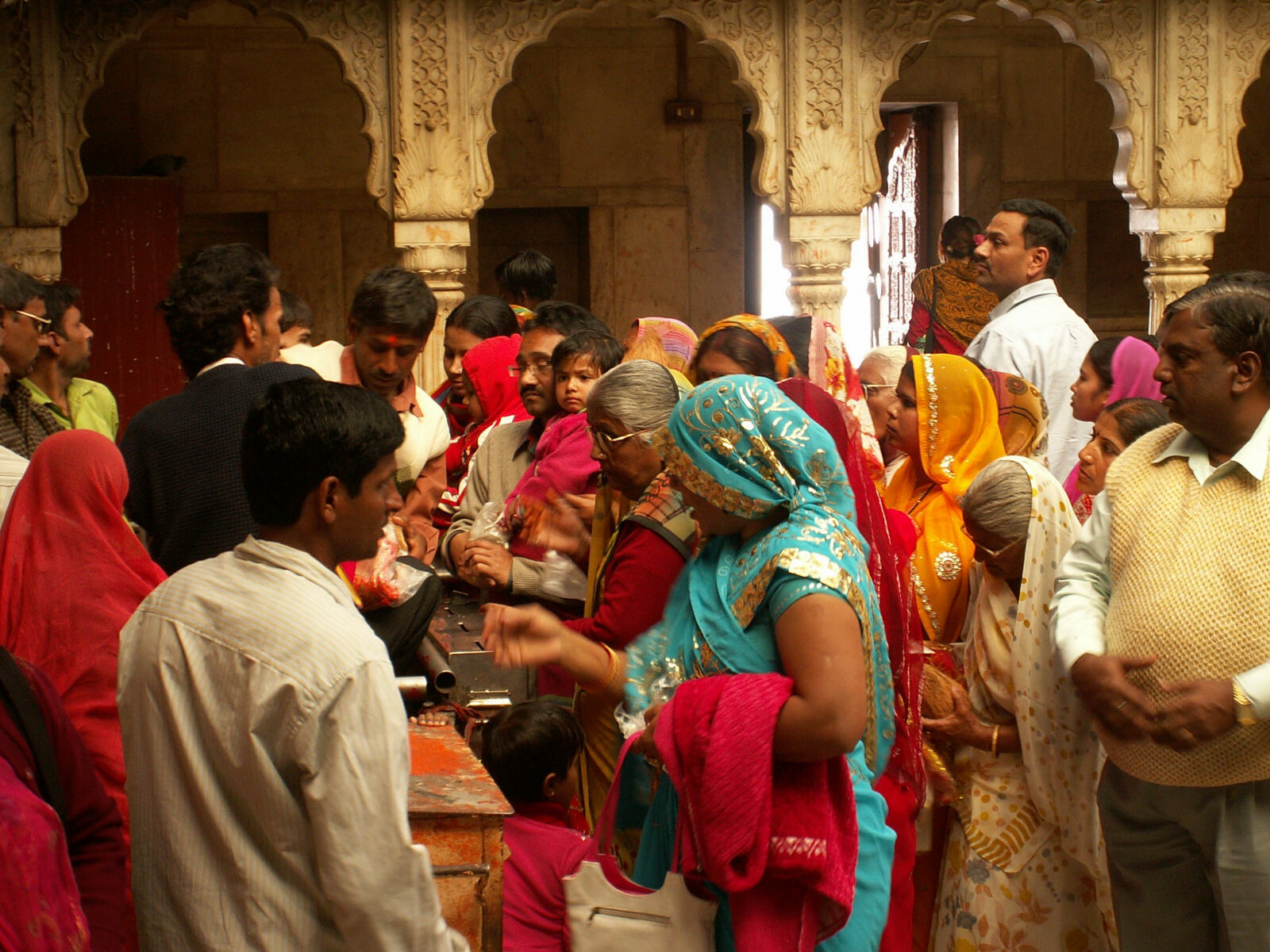 |
.... hundreds of which scampered to and fro all over the temple, coming out of holes in the walls, climbing up doors and railings and clustering round bowls of grain or coconut milk. |
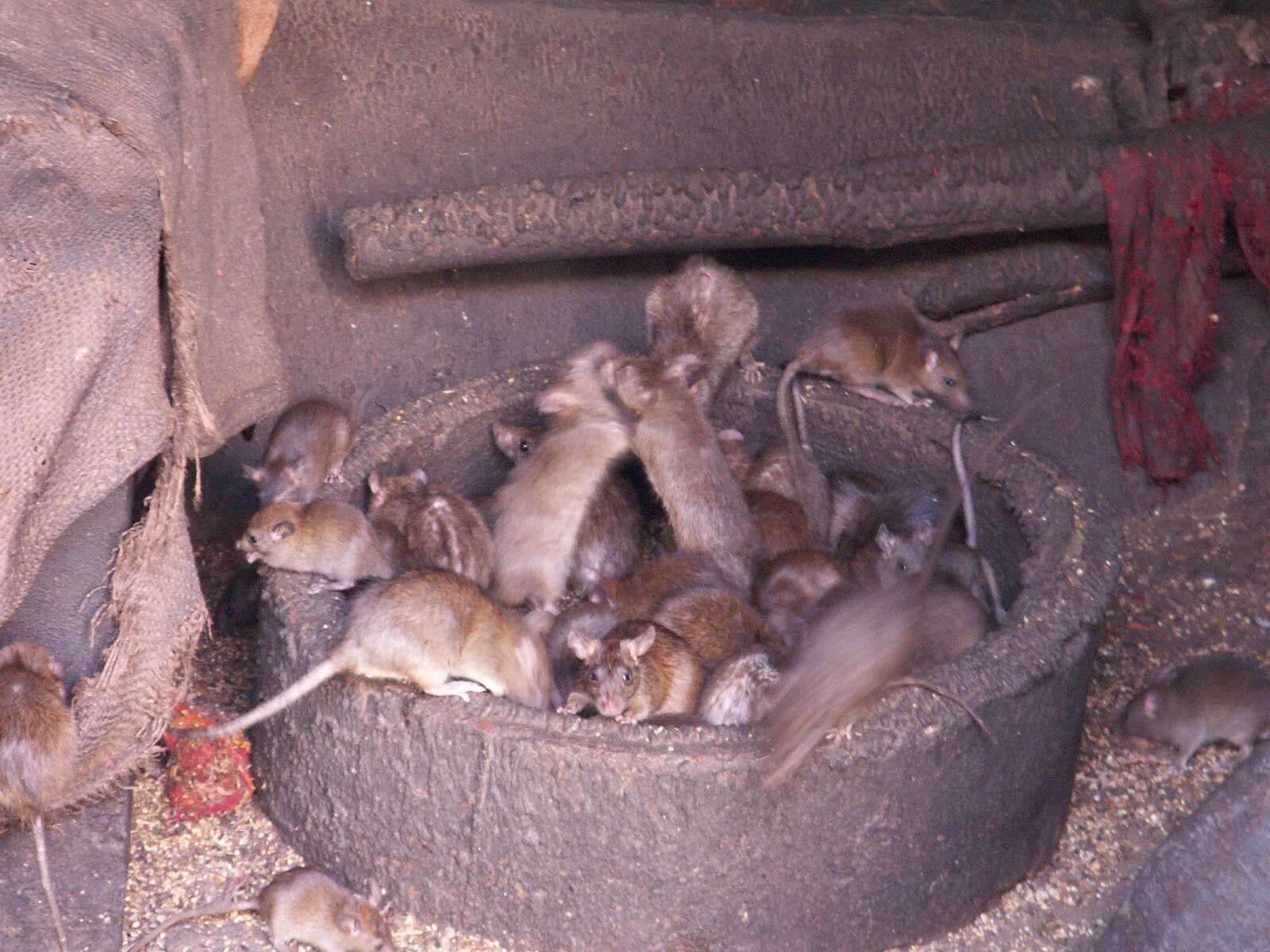 |
Despite being pampered and well-fed, the rats looked rather scruffy and mangy. If you stand still for a while they scuttle over your (bare) feet which is taken as a sign of good luck, although it feels very strange and tickly. |
 |
We went for a snack lunch in a restaurant opposite the railway station and ended up having two huge masala dosas, full of spicy veg and potatoes, then got the 17:00 Chandigarh express overnight train to Chandigarh. We had the two lower bunks in a 2AC compartment and the upper two were unoccupied, there was plenty of room and it was a pleasant temperature (not too much A/C) and we were very cozy in the bedding provided, so it should have been a pleasant ride if not for the guy in the next compartment snoring like a whole farmyard full of pigs at full volume, despite Sheila shouting and thwacking him twice on the soles of his feet with her shoes! She eventually moved to the other end of the carriage for the man's safety! |
Chandigarh union territory - Chandigarh |
Mon 2nd. When we got an auto-rickshaw at 6:30 at Chandigarh station it was still dark and so cold that the condensation on the windscreen was turning to ice. We went to Satyadeep hotel and while we were waiting for the day staff to arrive we had toast and tea in 'Sai Sweets' restaurant below the hotel, to warm up. Then we went out to see Chandigarh, which on first impression is not like India at all - it is set out in a grid pattern with wide avenues, proper pavements which are swept cleanish, and even cycle lanes. The commercial area, sector 17, has a very European feel to it with international shops and cafés set around a large open square. We got a cycle rickshaw past all the leafy parks with well-kept greenery and mature trees, up to sector 1, the Government area containing the high court and state parliaments. The whole city was designed and laid out from scratch in the 1950s by the architect Le Corbusier and at the time it was radically modernist, although to us it did not really live up to expectations and the buildings look rather dated now.
Not far from the high court we visited the Fantasy Rock Garden, which was started by one man called Nek Chand in the late 1950s using junk and organic matter discarded in the construction of the new city. It has now grown into an amazing 20-hectare labyrinth of walkways, staircases and waterfalls overrun by figures of people and animals made from china and glass shards, electrical sockets, ladies' bangles, wire and anything else that came to hand. It was great fun! |
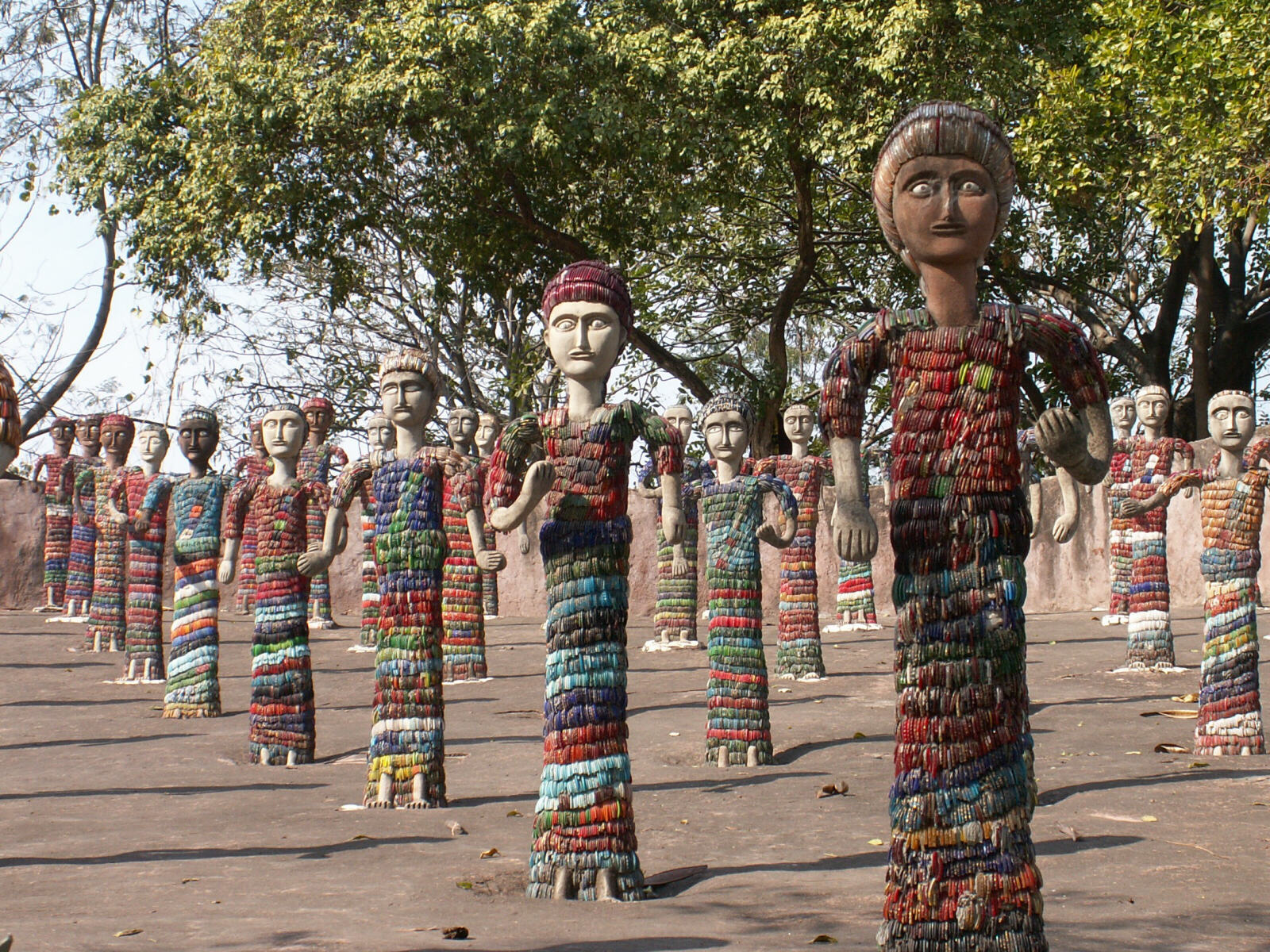 |
In the evening we walked back to Sector 17 and went to Blue Ice, a very trendy bar/lounge/restaurant with chrome metal high-chairs, TV screens showing sports and a DJ playing music, where we had some beers and a curry. |
Punjab state - Amritsar and Wagah border |
Tues 3rd. Buses to Amritsar depart at 6am or 2pm and we decided to go for the early one, which was a mistake. We had pre-booked the 'luxury coach' and when an old jeep turned up and took us to the bus station, we followed everyone else to a nice, comfy-looking coach but no, they diverted us (only us!) to an old boneshaker, which was freezing cold all the way, even though they found some blankets for us. At the half-way breakfast stop we had spicy samosas and dhal which warmed us up a bit. When we arrived we went by cycle-rickshaw to Mrs Bhandari's guest house, which is not mentioned in the latest Lonely Planet guide but I had heard of somewhere. It is a haven of peace, in an old building in the Cantonment (raj-era administrative/military area) with tables and chairs outside each room where you can sit with a cup of tea looking at the nice gardens, protected from the noise of the city and barking dogs by high brick walls. The rooms have fireplaces stocked with wood for the cold evenings, they provide hot water bottles and the guest-house even has its own small dairy herd of water-buffalo providing fresh milk and yoghurt!
After lounging around enjoying the ambience for a while we got a cycle-rickshaw to the old city intending to visit the Golden Temple, but we were immediately waylaid by a man offering a shared minibus tour to the Pakistan border to see the famous daily border closing ceremony, so we went. Huge crowds pack the grandstands on each side of the border, and enthusiastically cheer on their side, as the soldiers in fancy plumed uniforms yell orders and goose-step exaggeratedly to and fro .... |
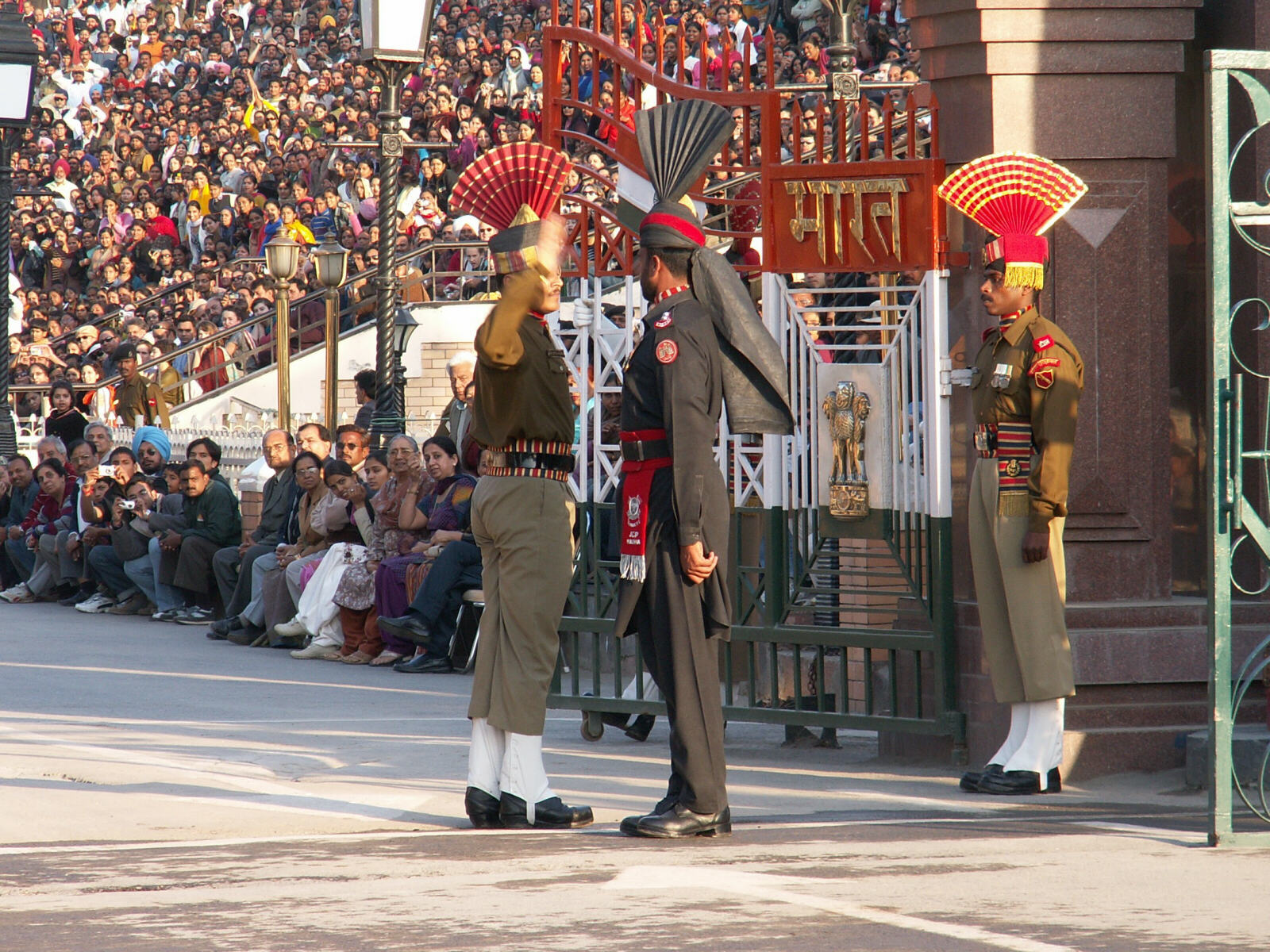 |
.... until the moment when the two commanders briefly shake hands, the flags of both nations are lowered and the gate is slammed shut. It was a wonderful piece of Disney-style theatricals with Ministry of Silly Walks touches. |
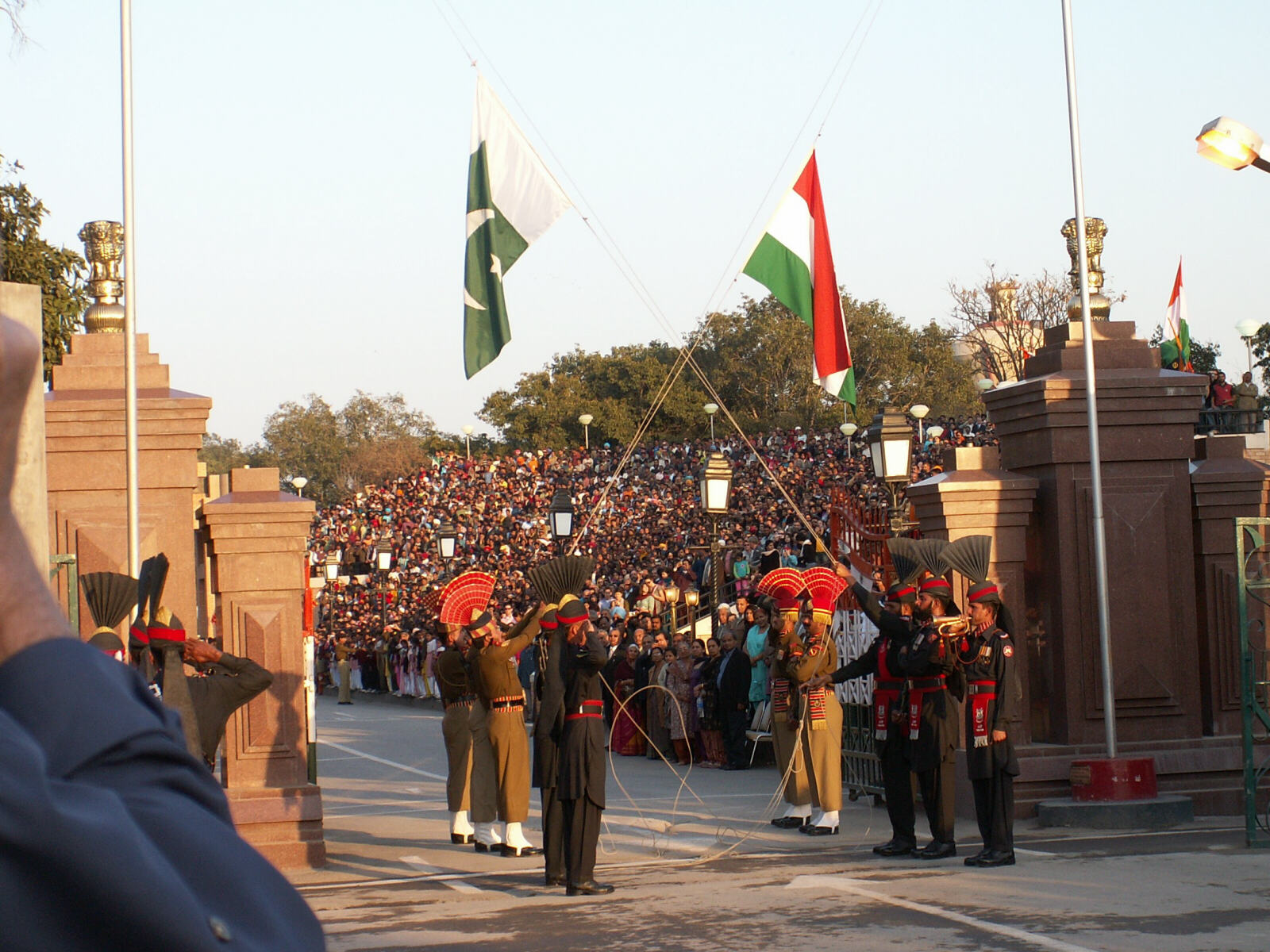 |
We got back to the Golden Temple after dark and went in to see it, but first we had to have our heads covered. Sheila already had a pashmina (she must have one in every possible colour now after all these trips to India) but I had to go to the scarf counter where a man tied a little turban on my head - he did it most skilfully, but so tight it cut off the circulation! Then we went in to see the temple and it was absolutely magical - the illuminated Golden Temple sits shimmering in the middle of a clean artificial lake while pilgrims and worshippers circulate along the walkway round the lake, bathe in the sacred waters and queue along the causeway to the temple itself, where gurus sit chanting or reading from the holy books while the chant is relayed to loudspeakers where it echoes round the spotlessly clean buildings which surround the whole ensemble. We were captivated and spent some time following the crowds around and up and down the different levels inside the temple. |
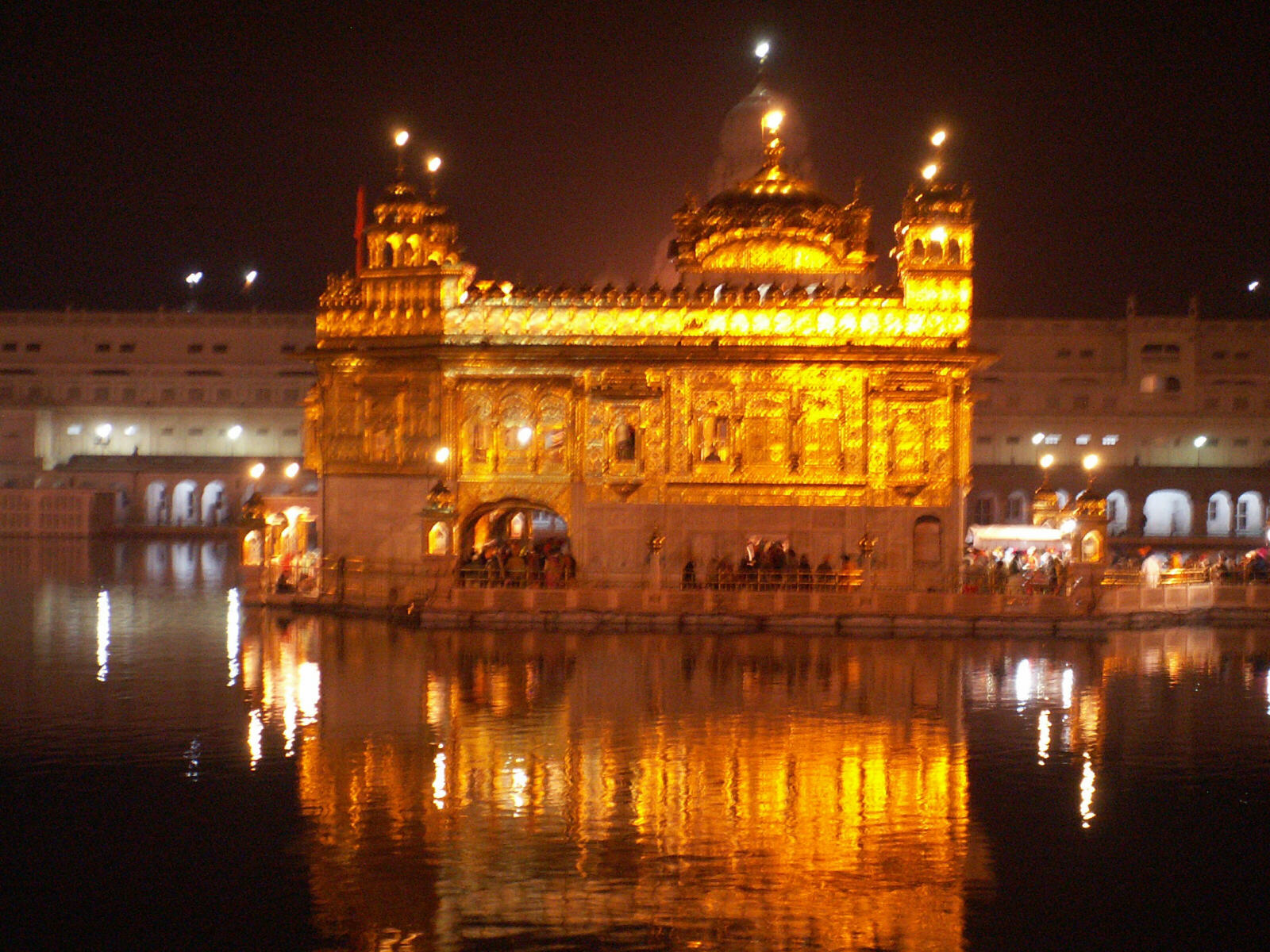 |
Finally we went by cycle-rickshaw through the chaotic bazaars, such a contrast to the clean, sparkling temple, to the Crystal restaurant where we had another good meal.
Wed 4th - Thurs 5th. We whiled away the mornings and the hot middle part of the day pretending the Raj era continues - we had breakfast on the table outside our room beside the garden, had hot baths in the big cast-iron bathtub in the bathroom and sipped tea in another part of the gardens. The dairy buffalos lazed in the sun which shone as it has every day since we left the haze of Mumbai and the guest house staff pottered to and fro gently carrying out their allotted tasks. |
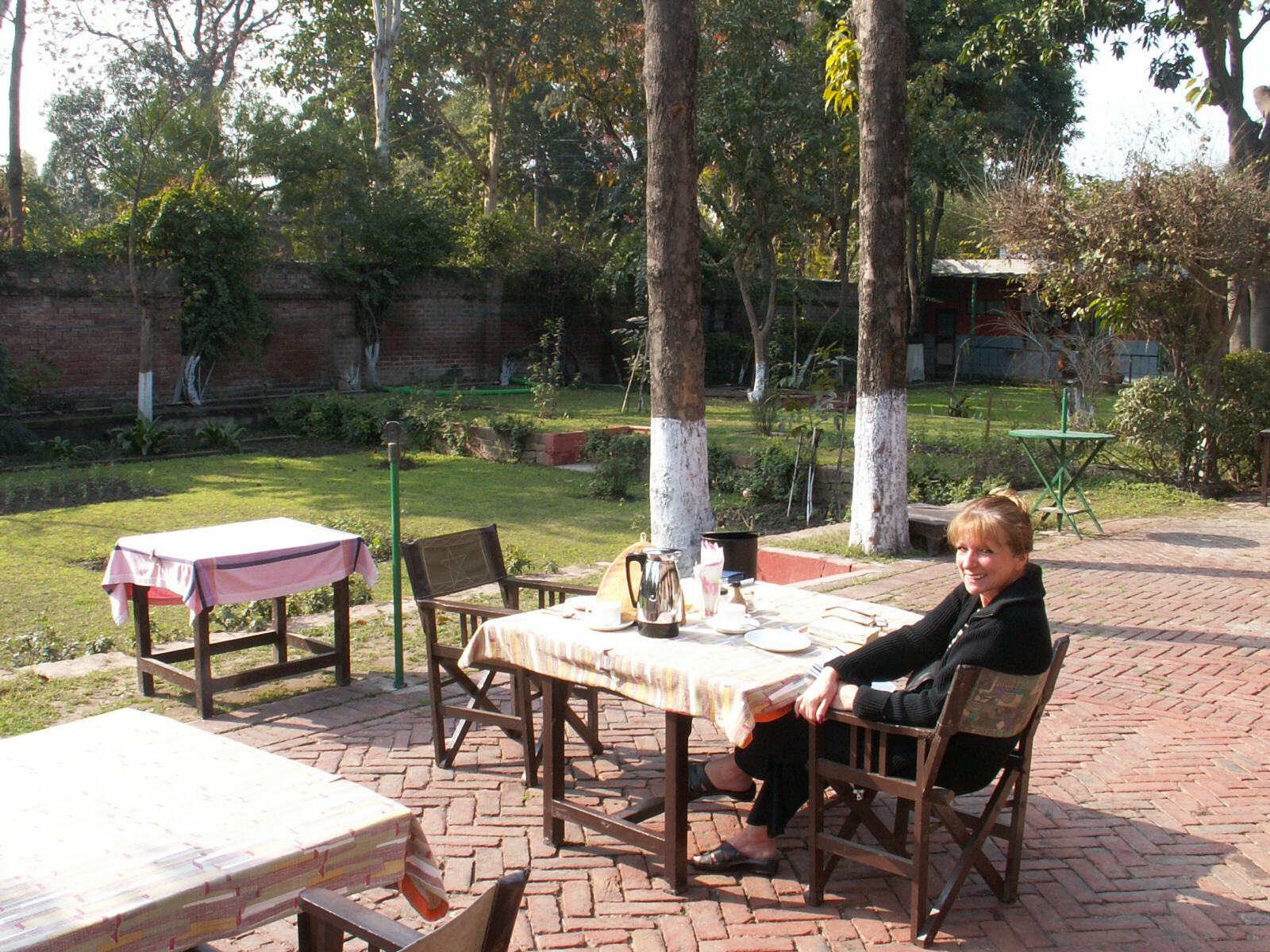 |
One afternoon we went to the Golden Temple in daylight, where it was still very impressive sparkling in the sun, then walked back through a cloth bazaar looking at all the garish fabrics covered in sequins and glitter. |
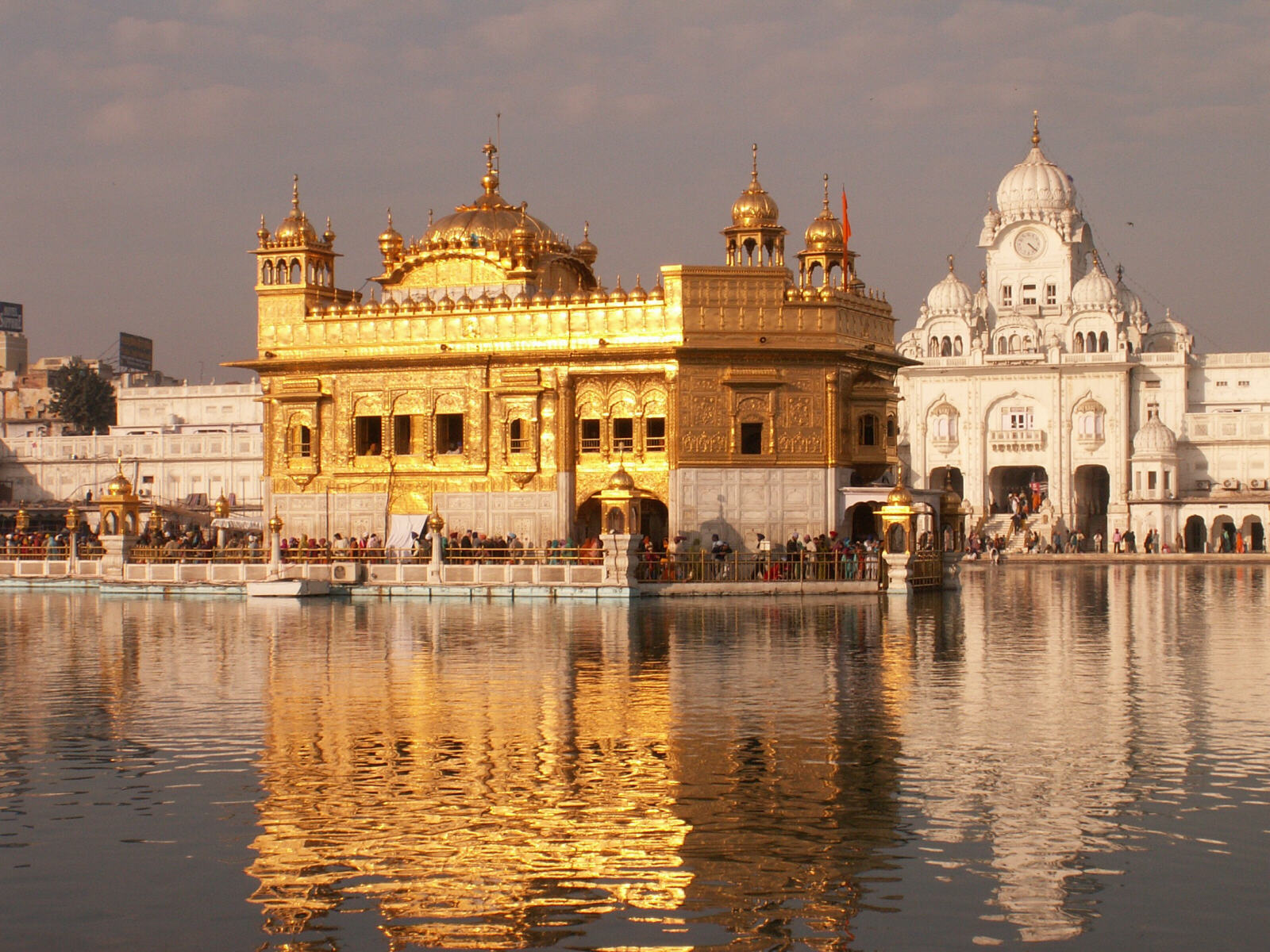 |
One morning a family who had been staying at Mrs Bhandari's guest house suddenly got into a big German-registered camper van that we had not noticed before and drove out waving goodbye to everybody - we discovered that they were taking six months to drive from Germany to Nepal and back, including across Afghanistan, but we were too late to ask them all about it. We later discovered their web site at - http://www.nomadic-one.com After they left, we seemed to be the only people staying there. On our last evening another guest arrived, a nice lady from Singapore visiting her daughter who is at school in Amritsar, and she just happened to have a bottle of Sula Indian champagne, so we sat by the garden and drank it and chatted. |
To continue to part 3, Pakistan, please click the mosque. 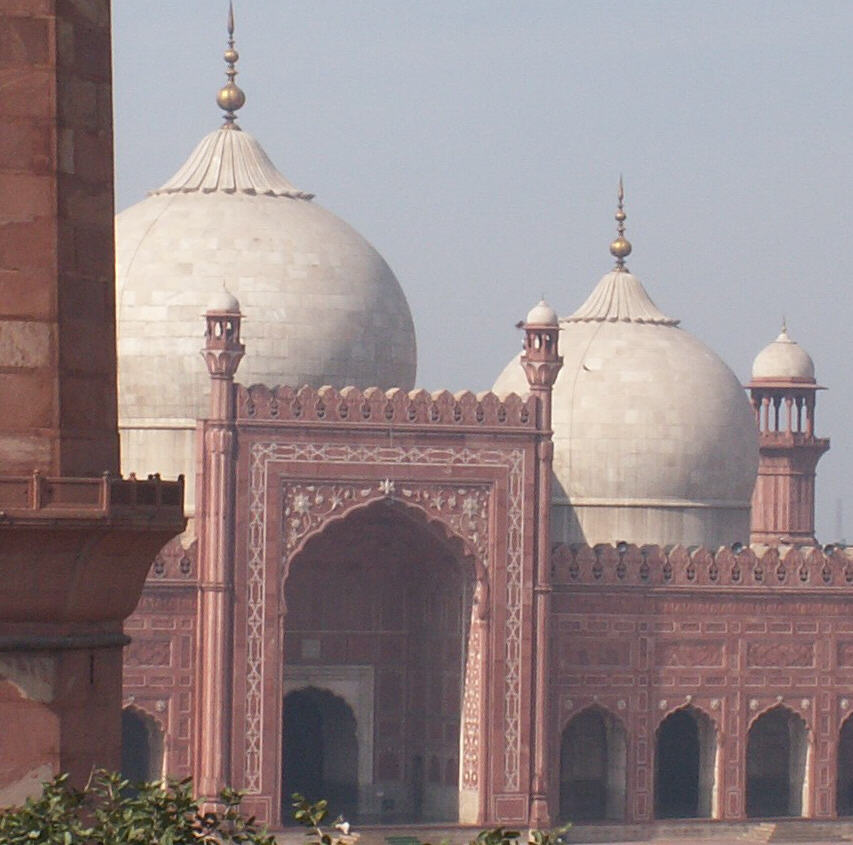 |
Or if you would like to see more of our travels just click the map.
